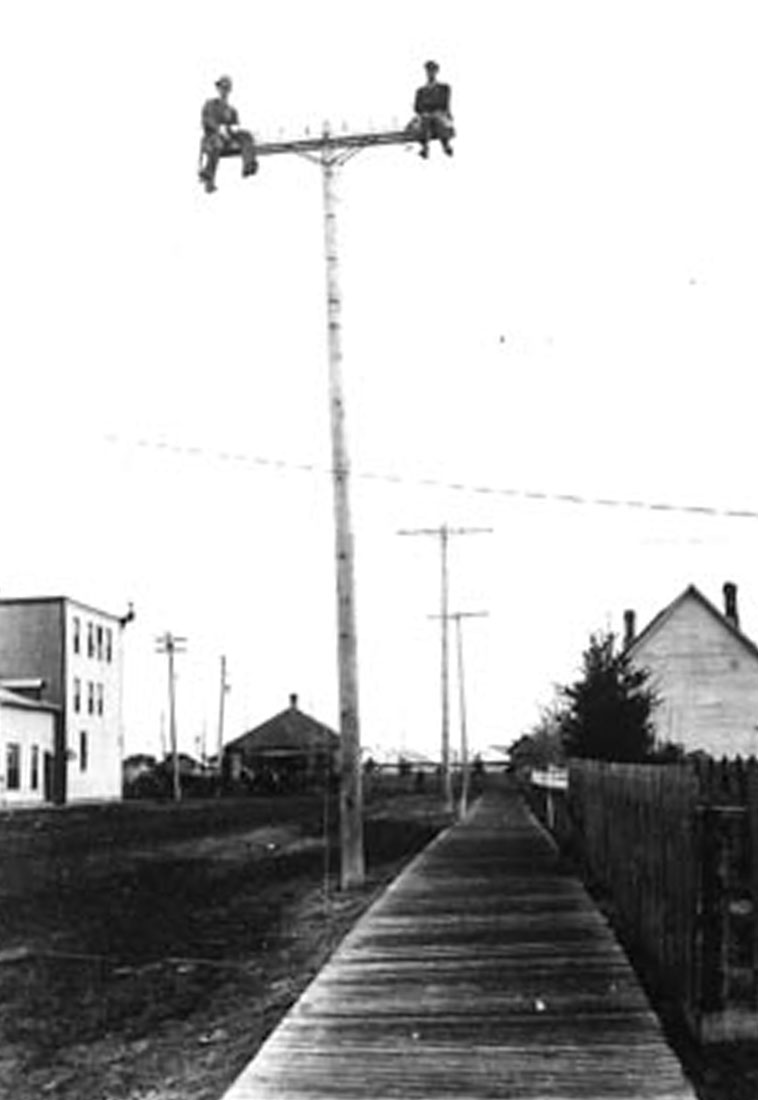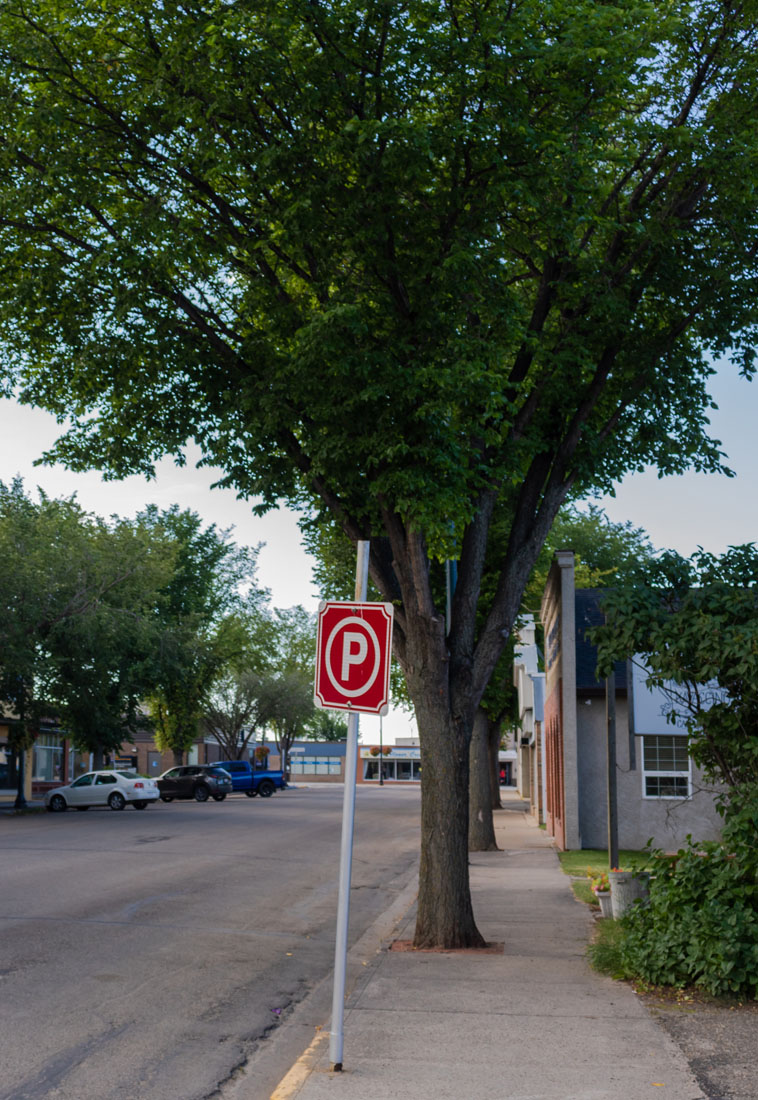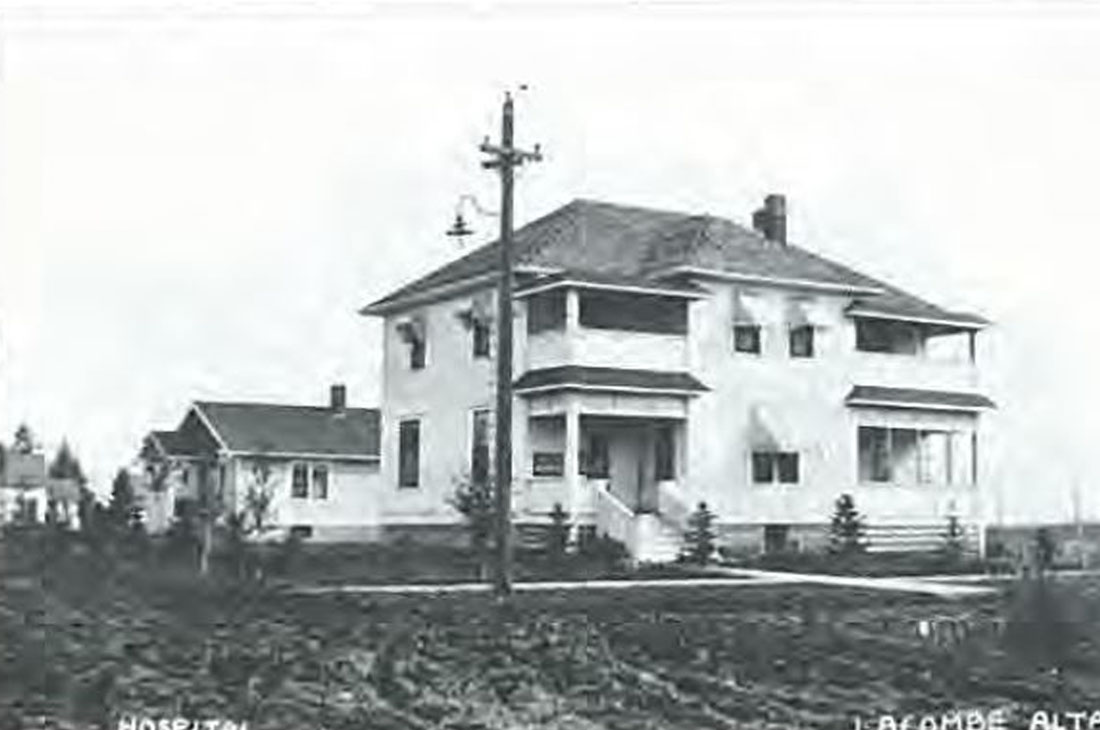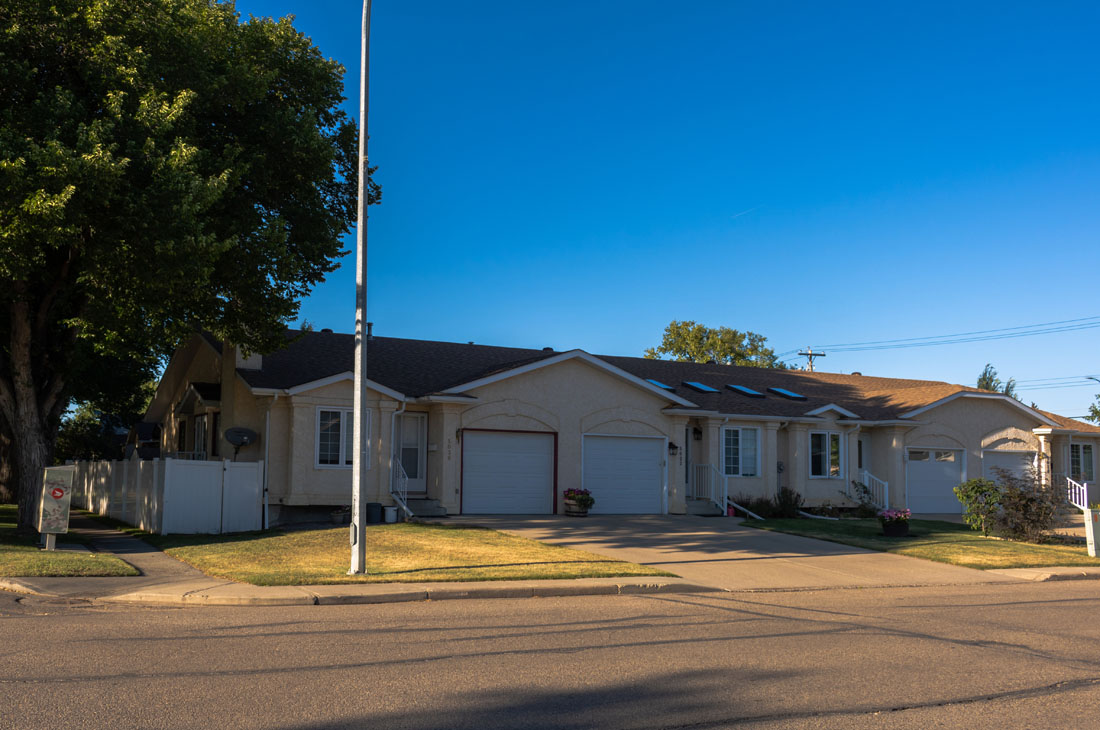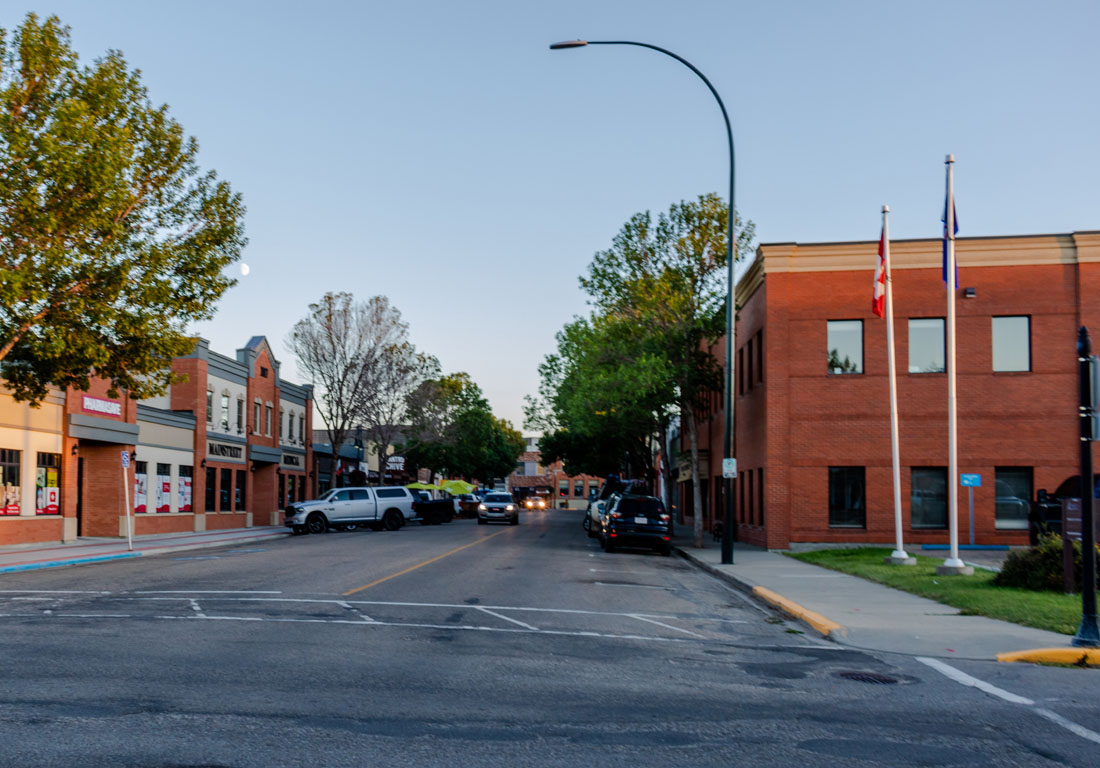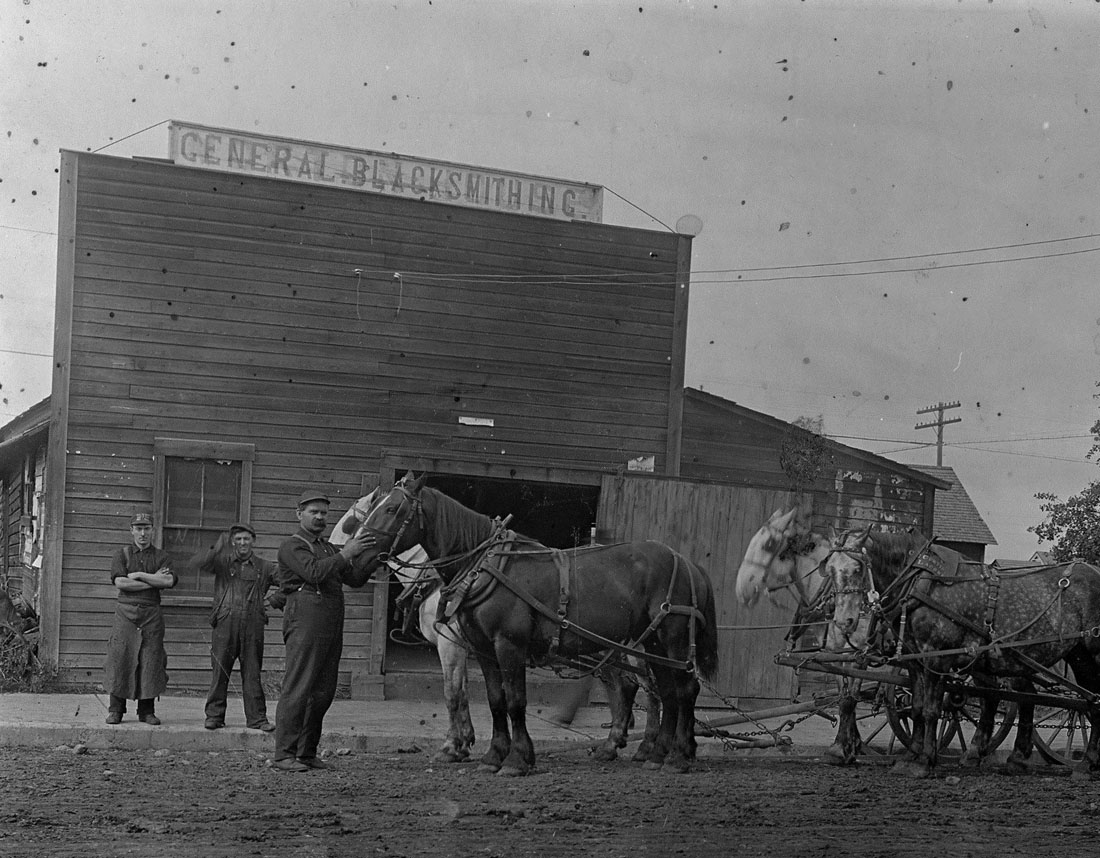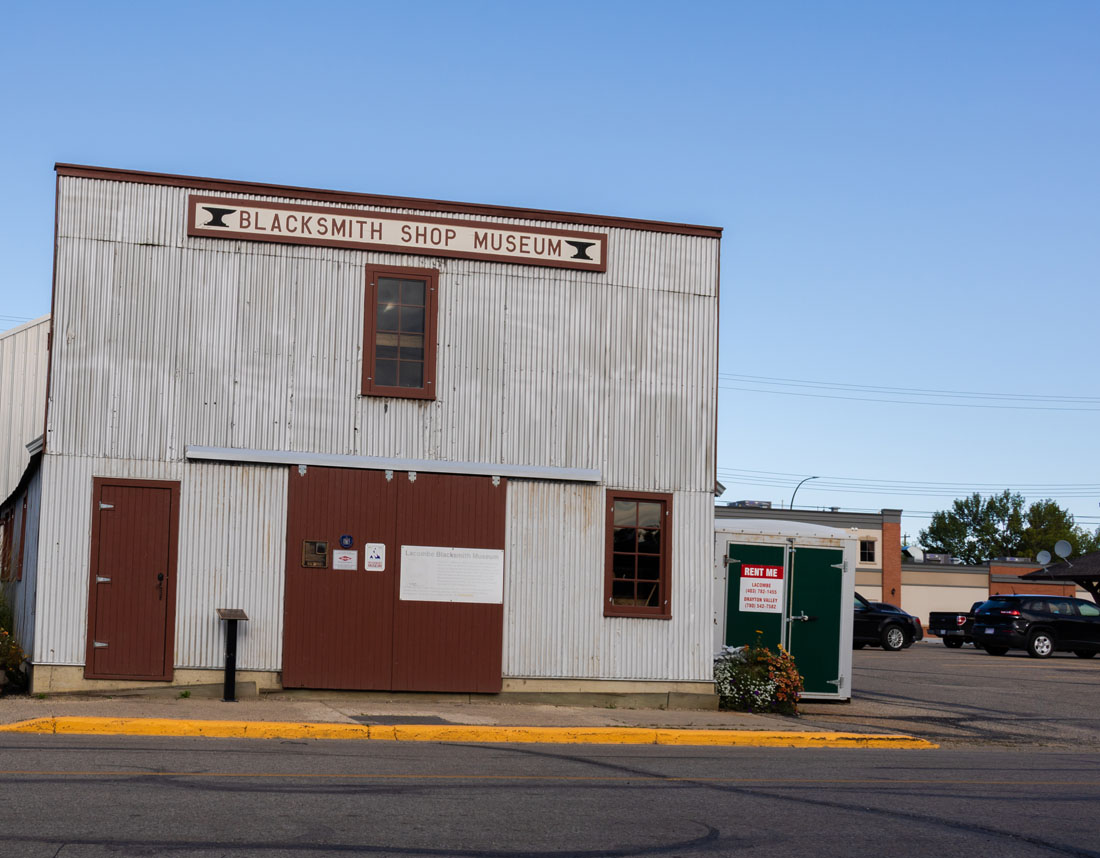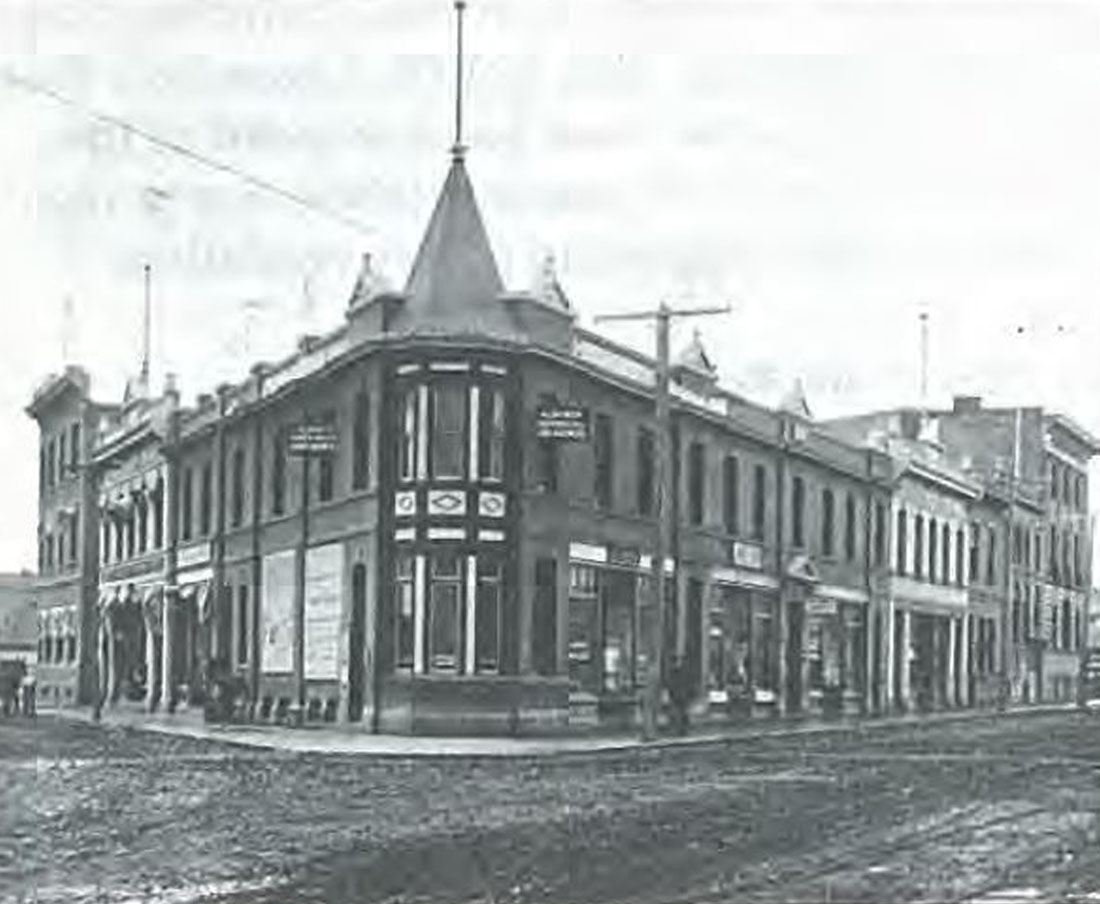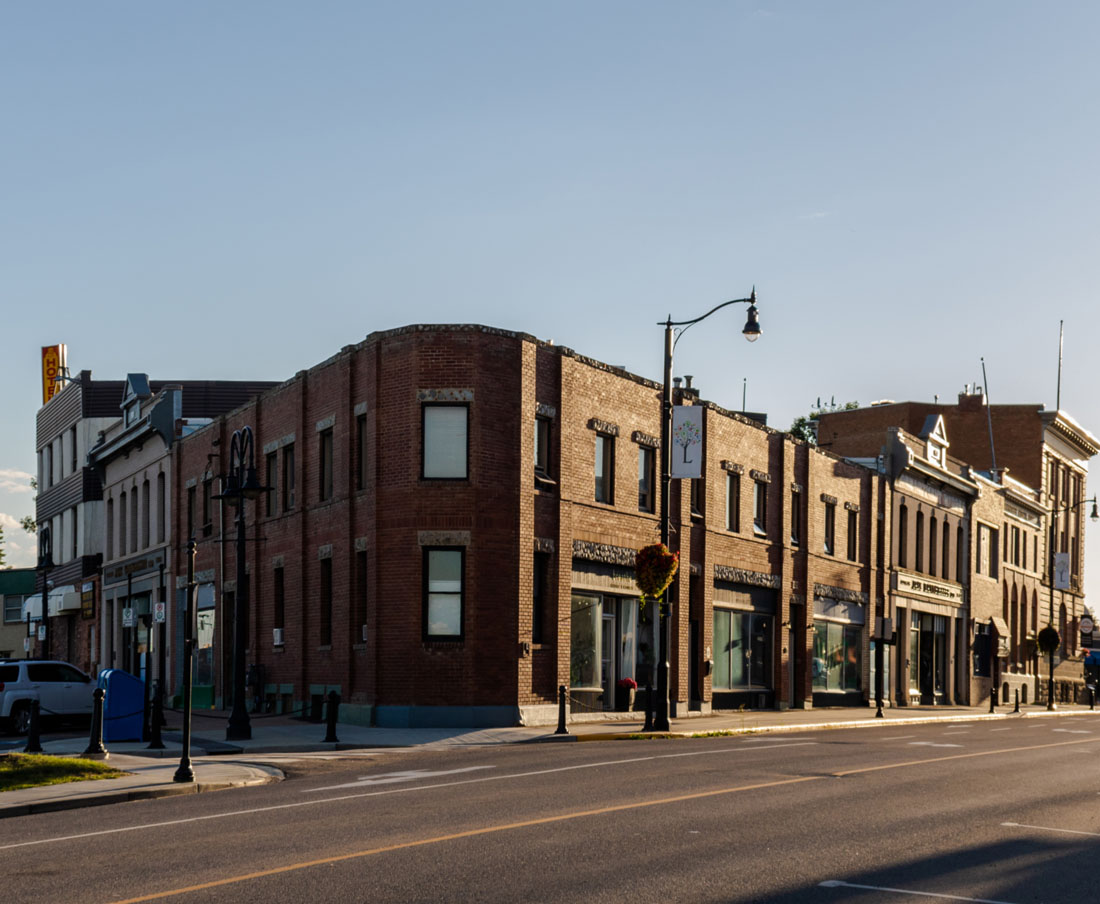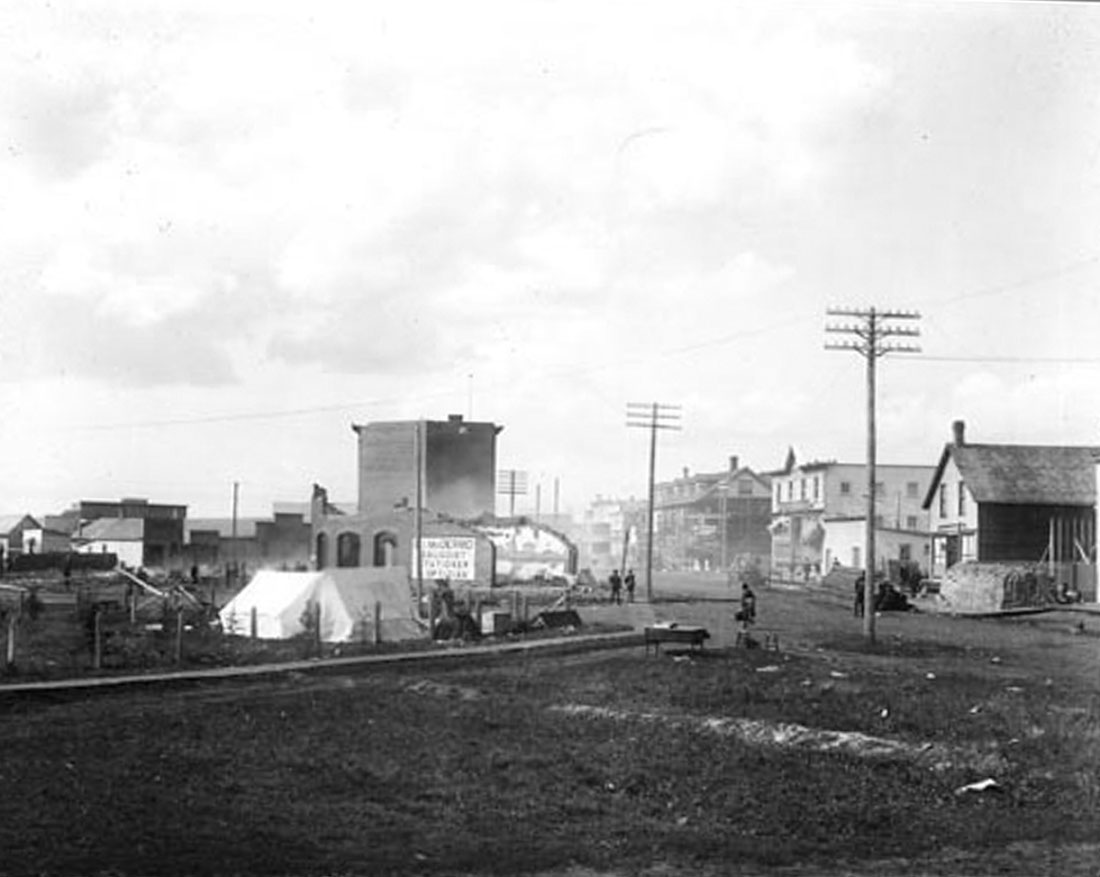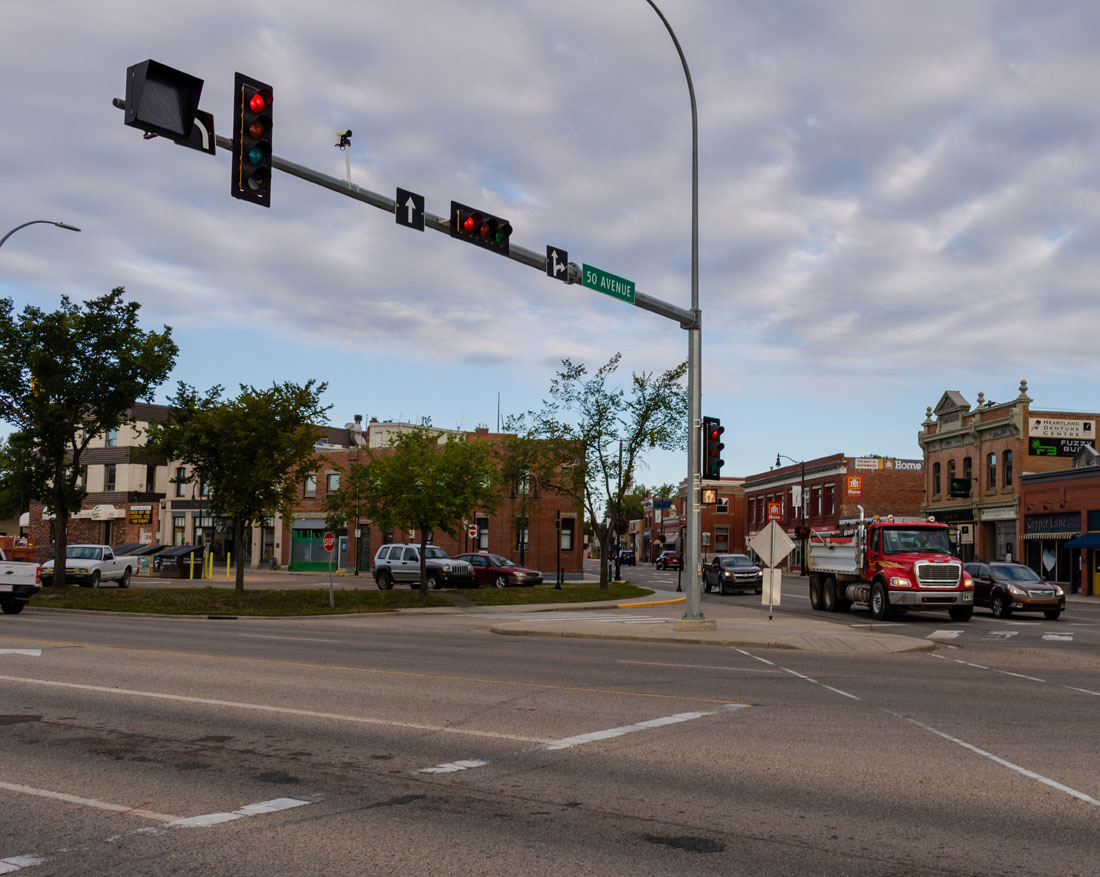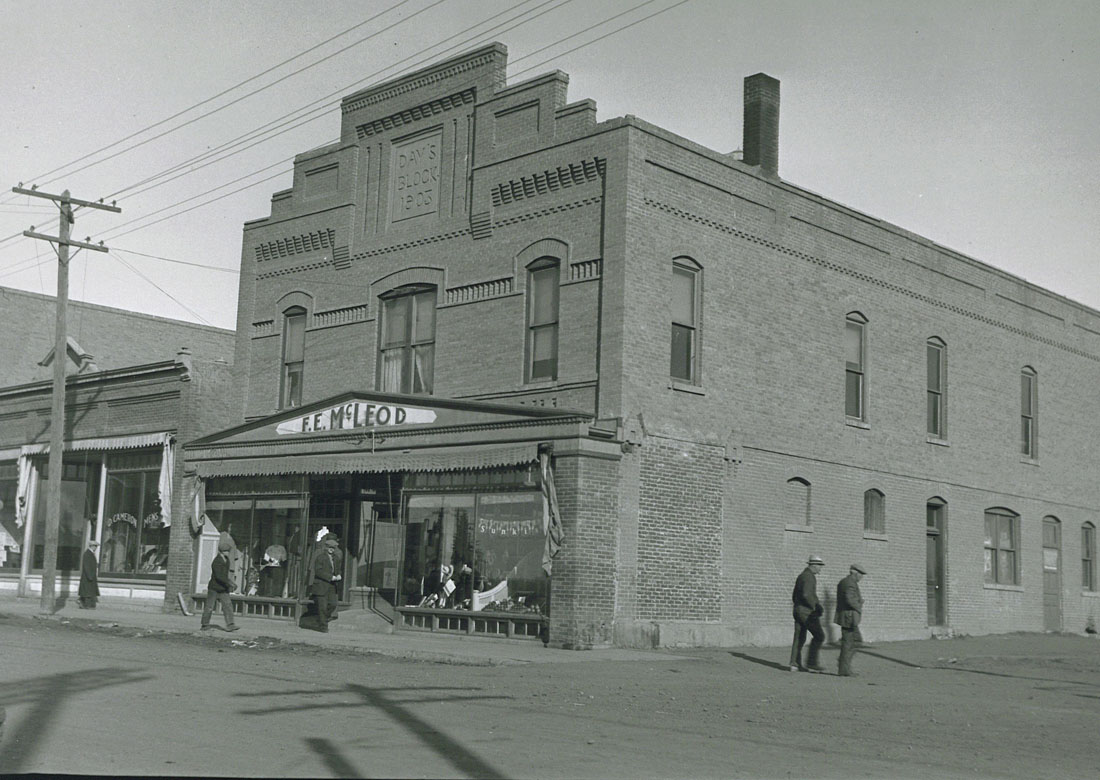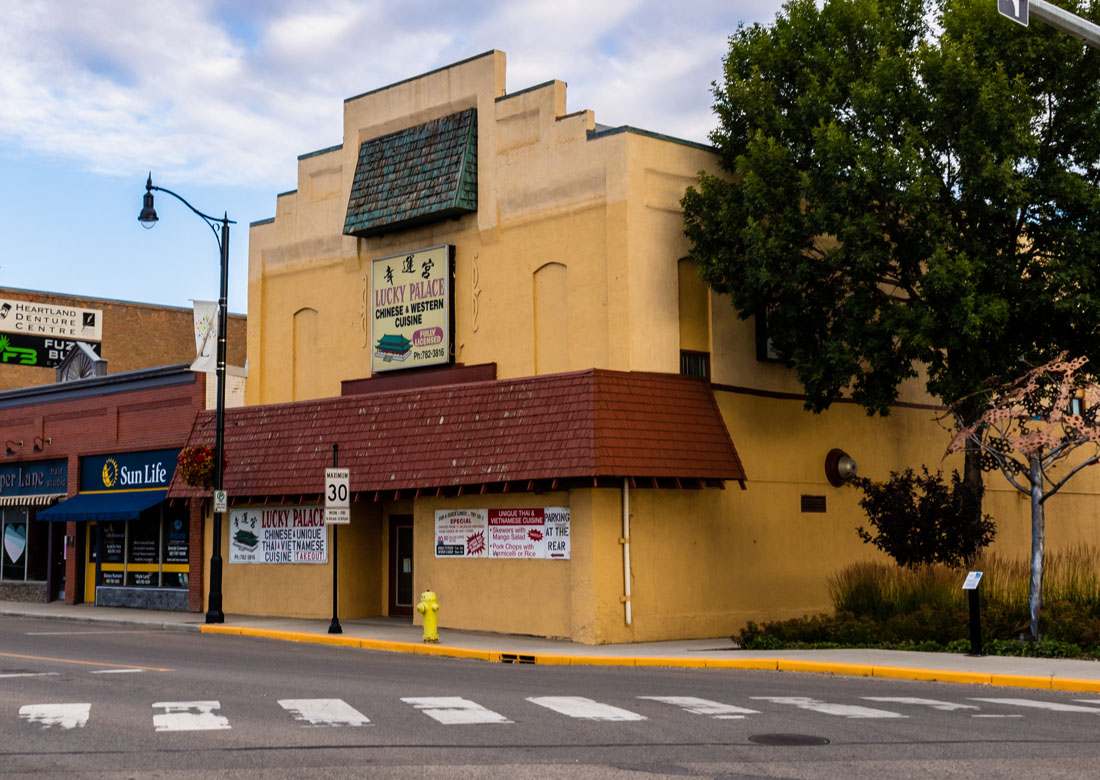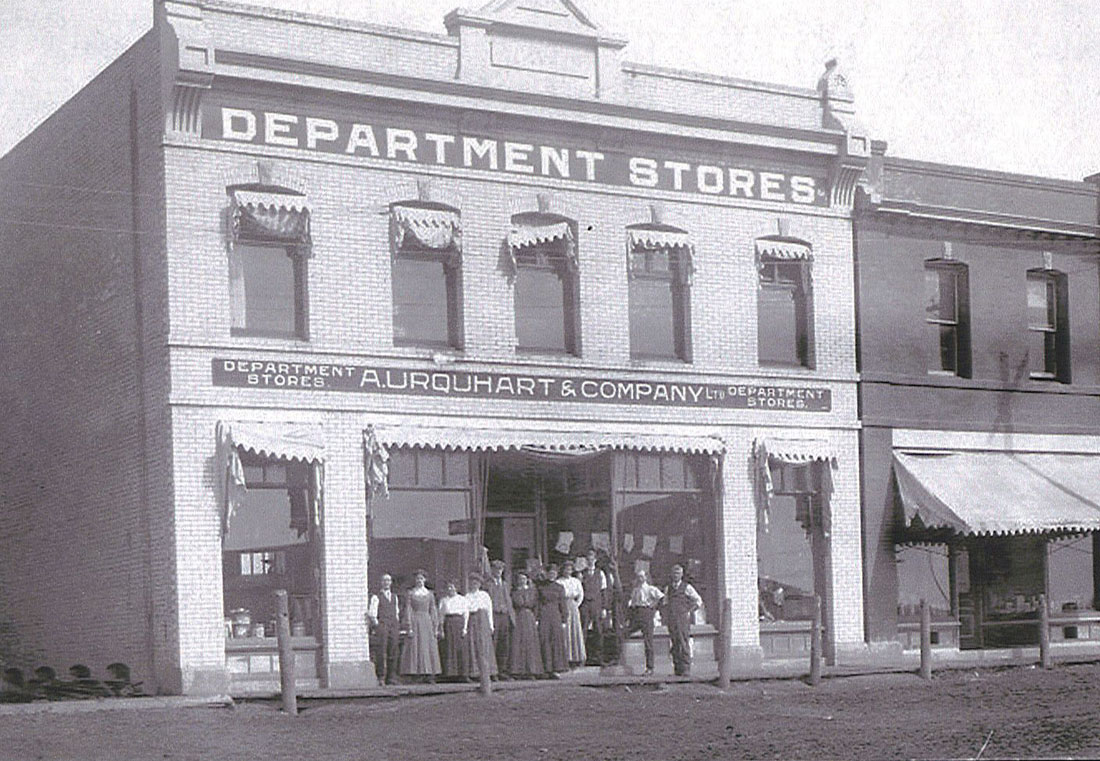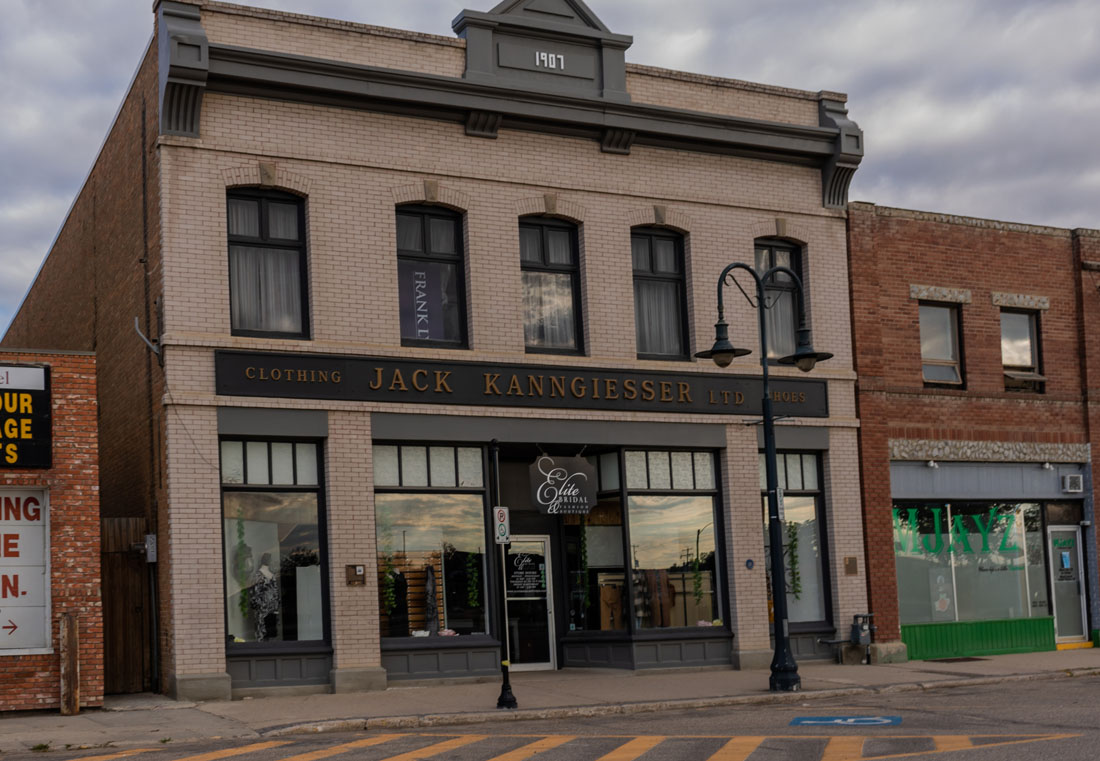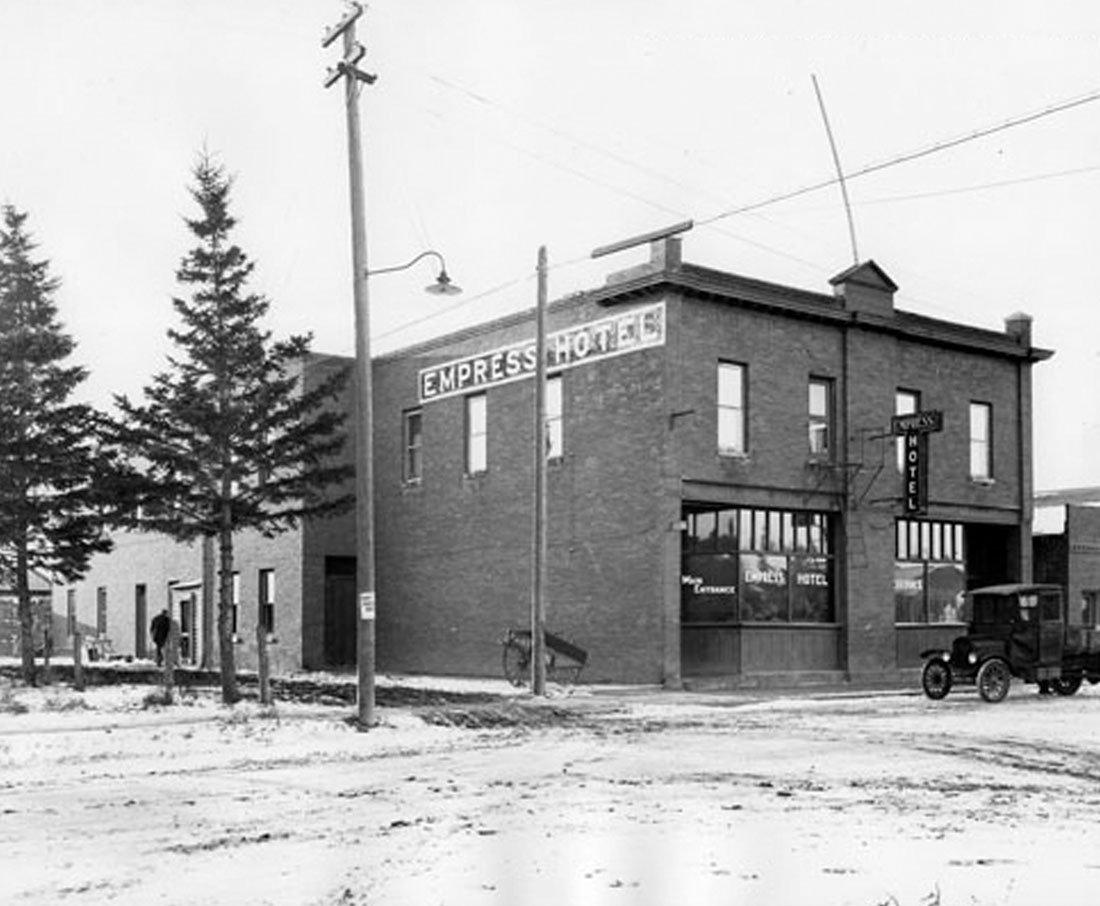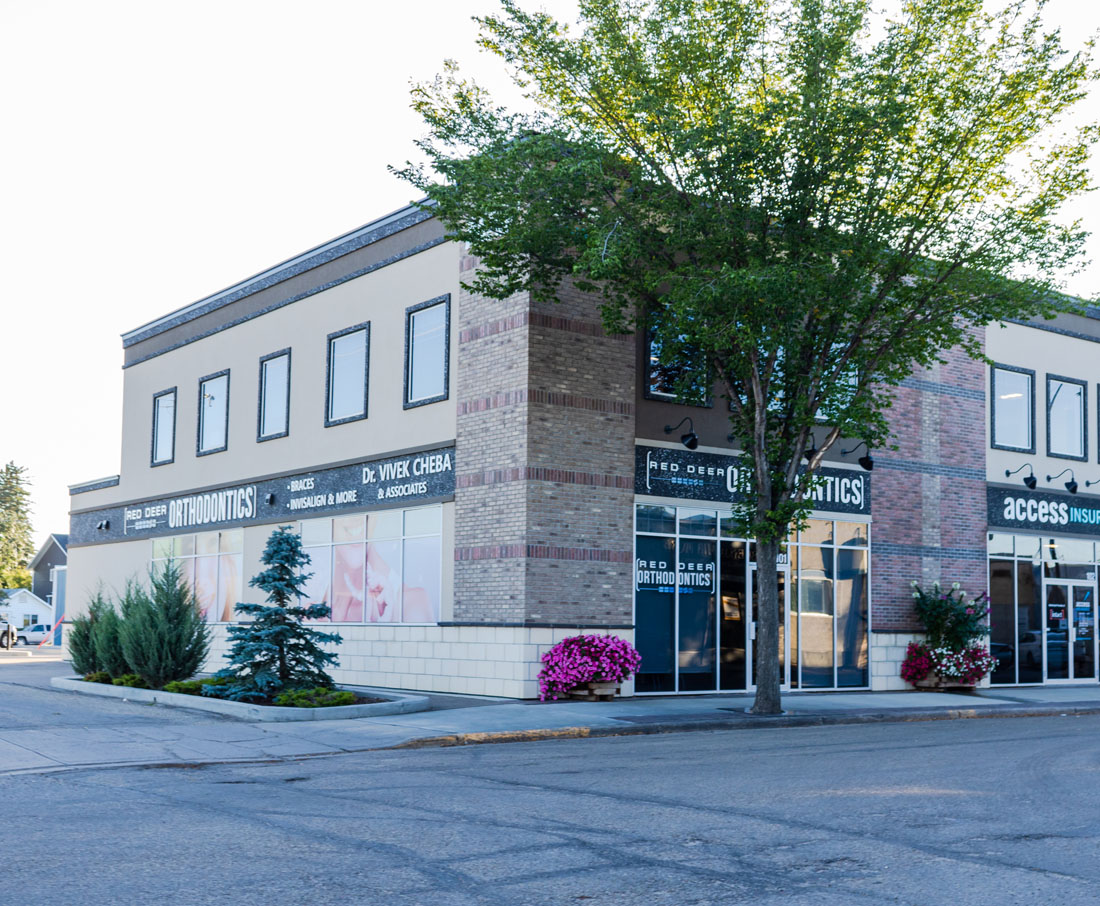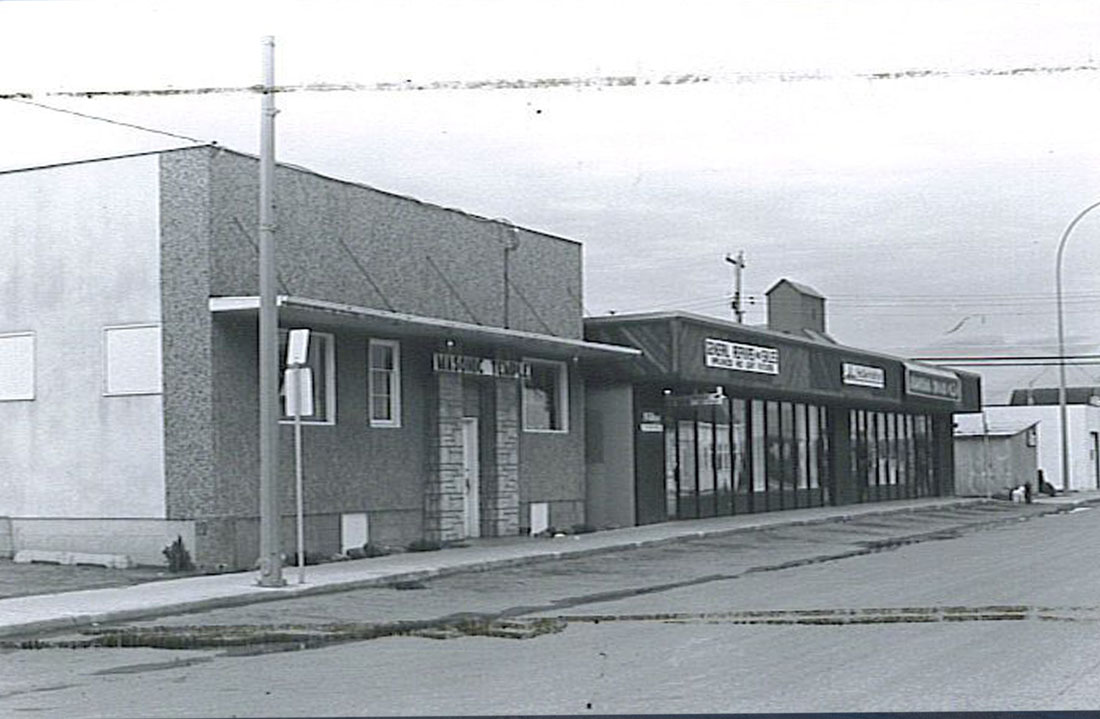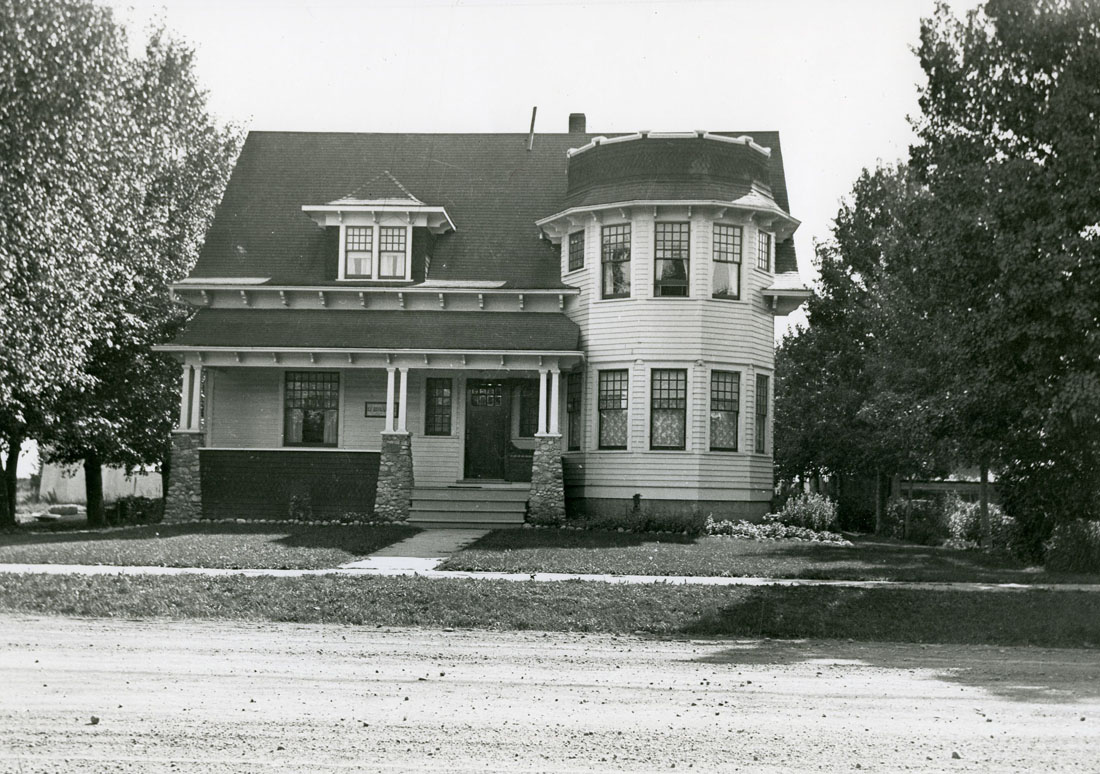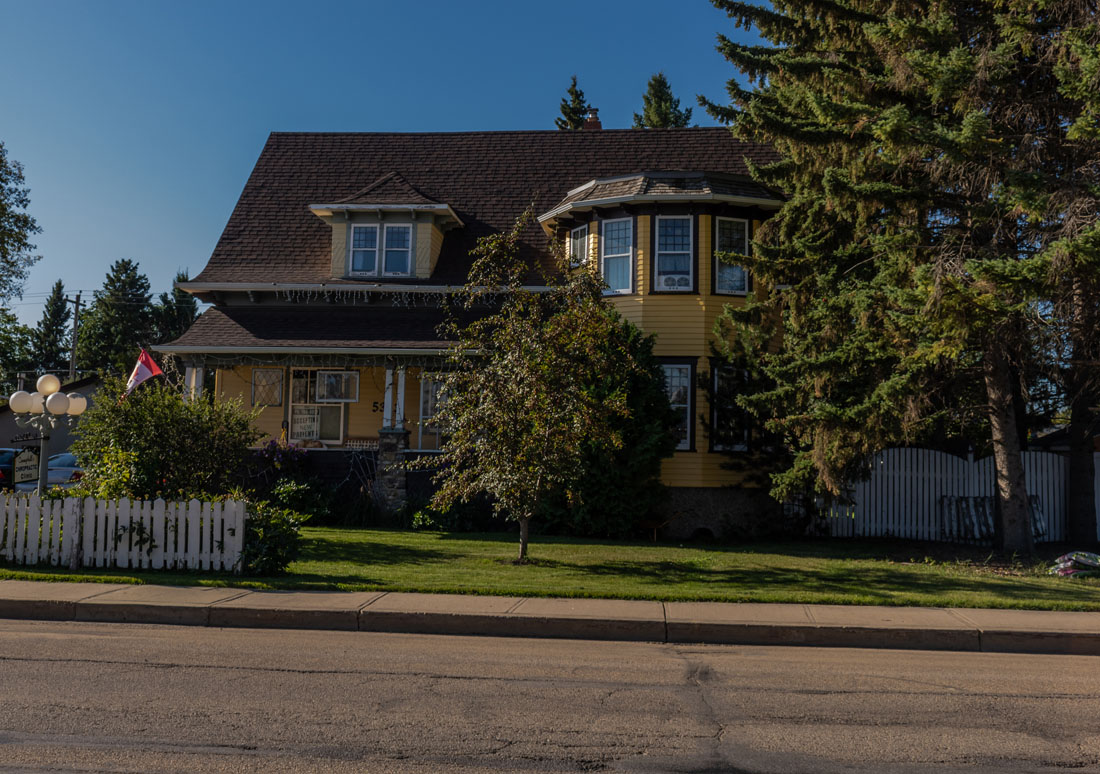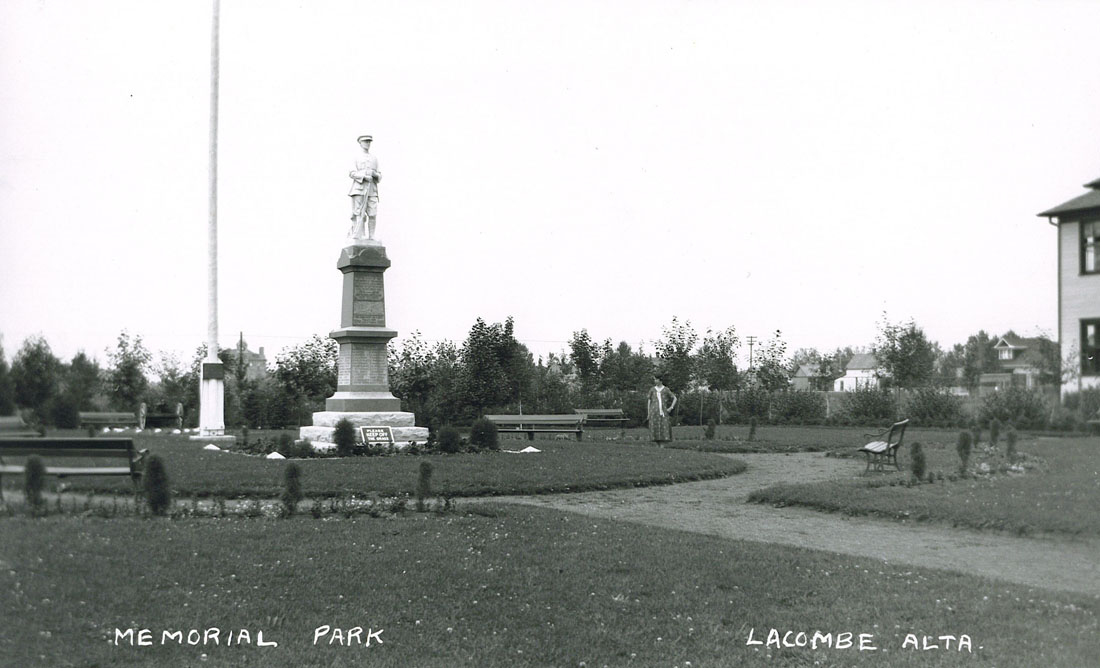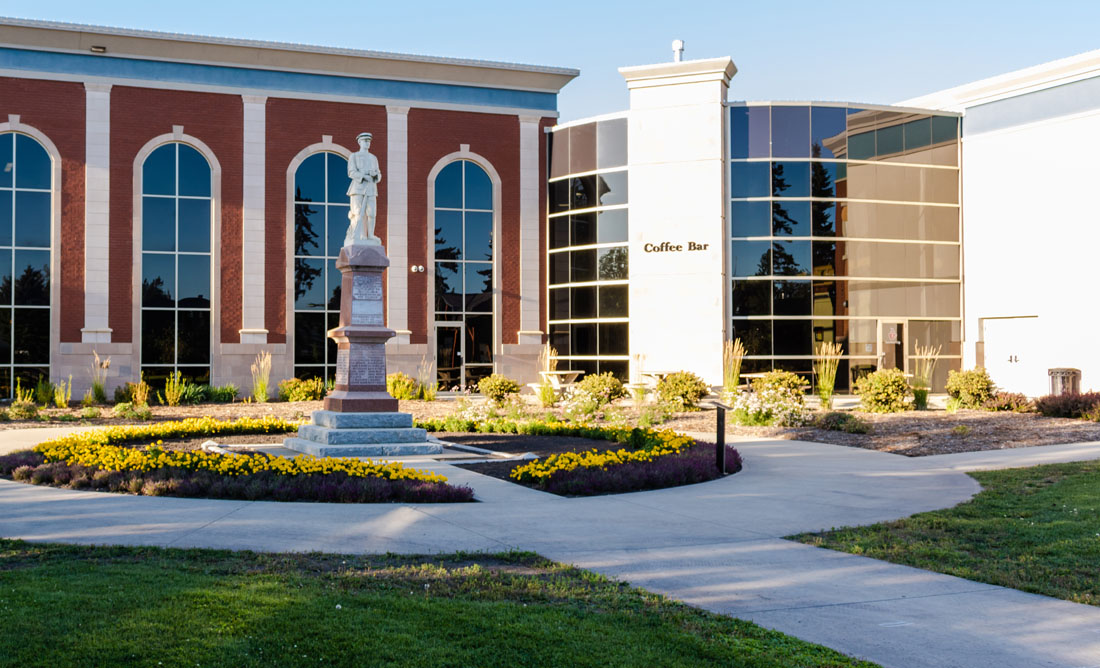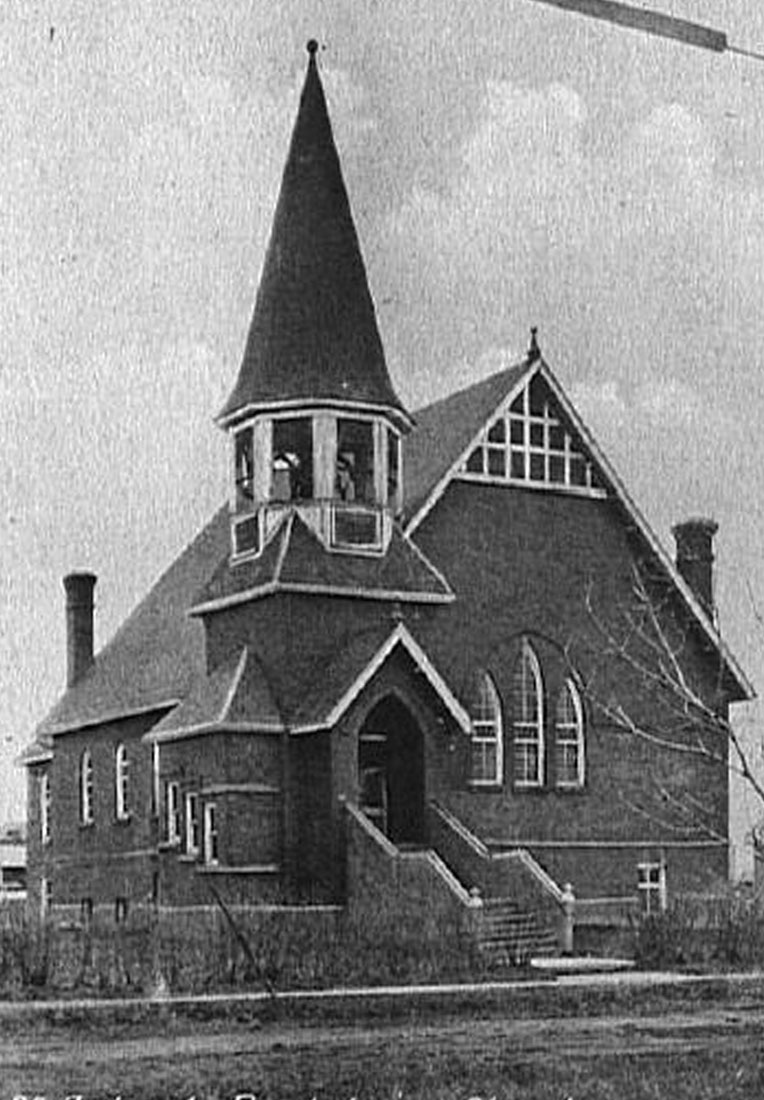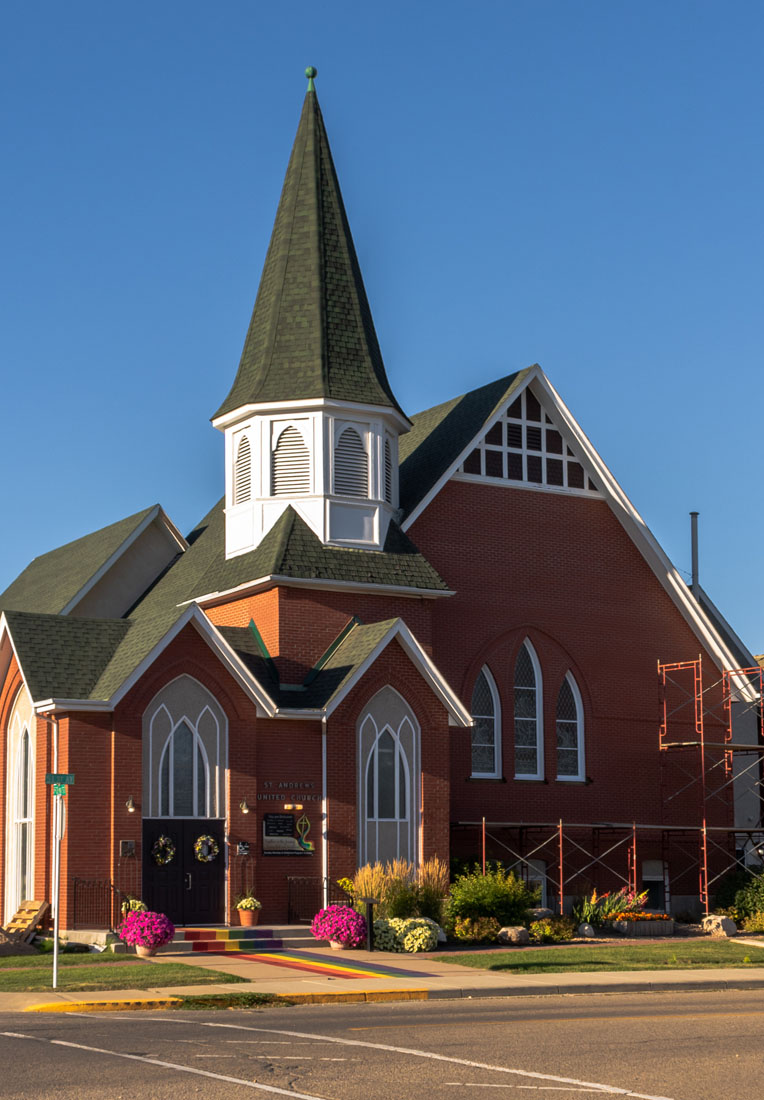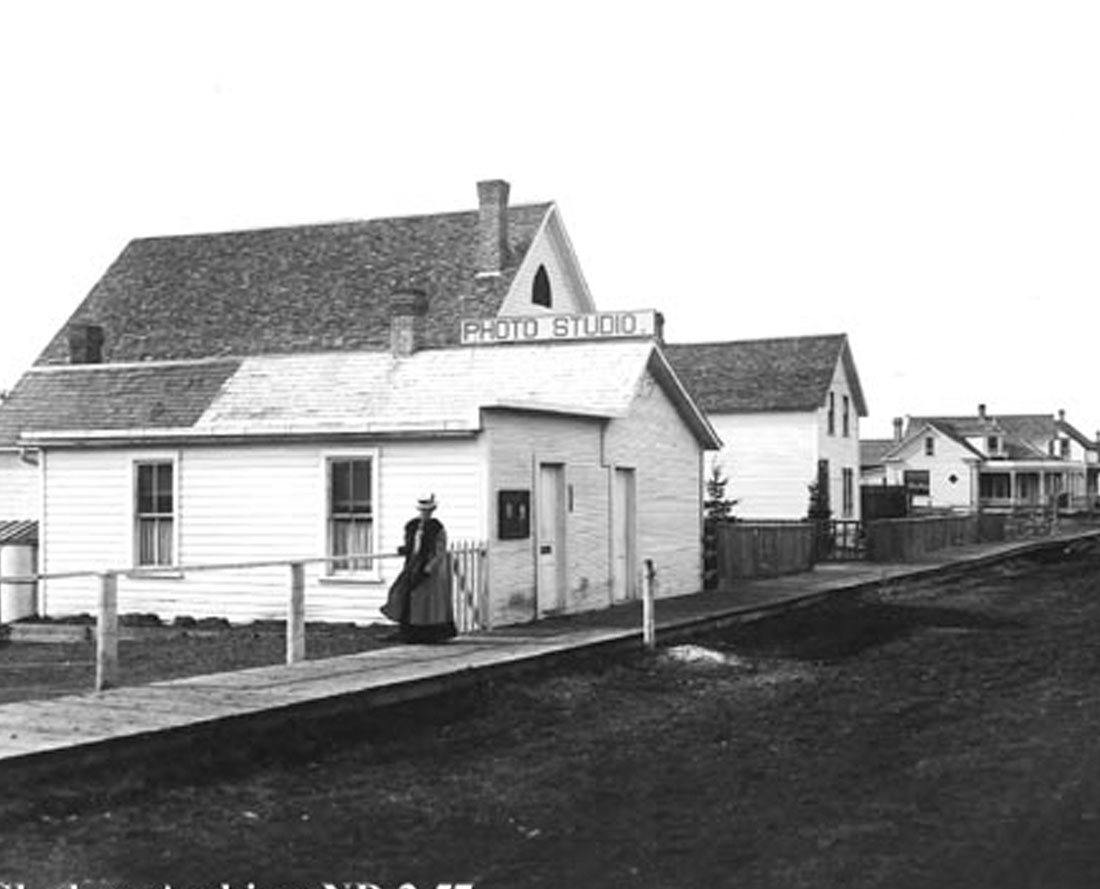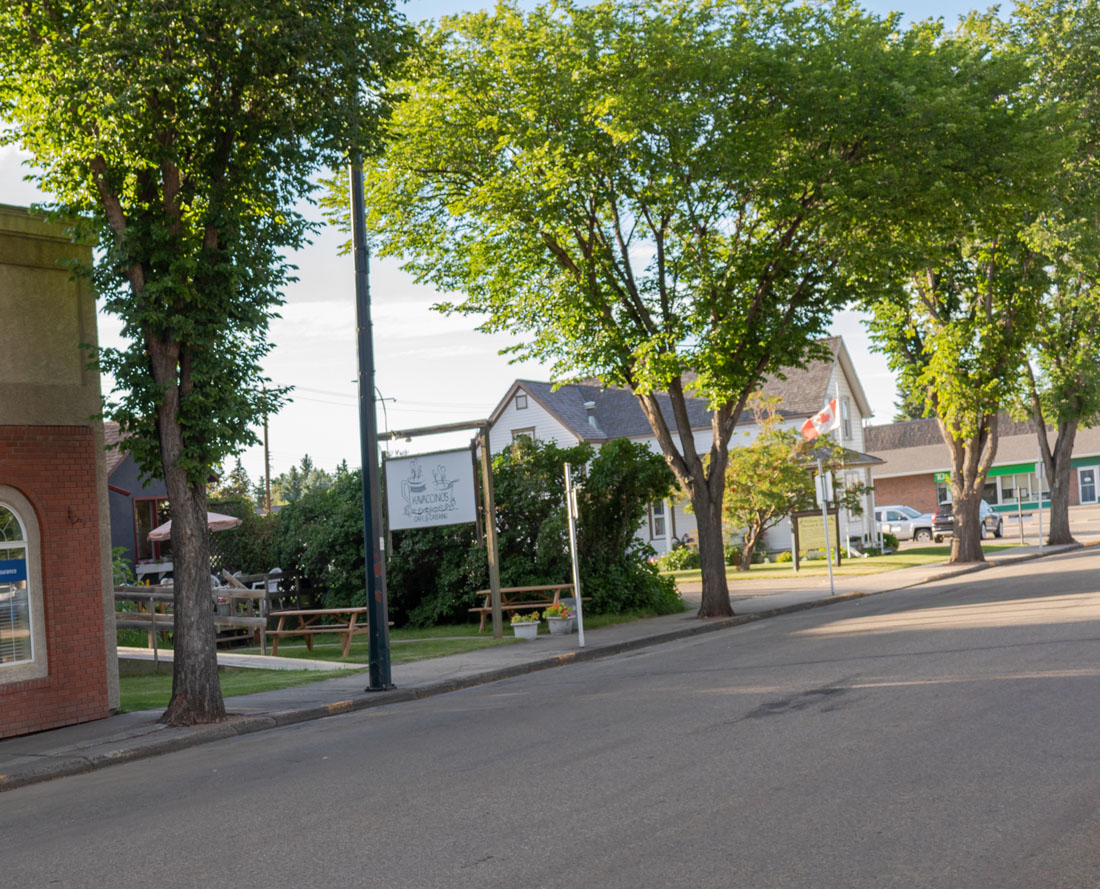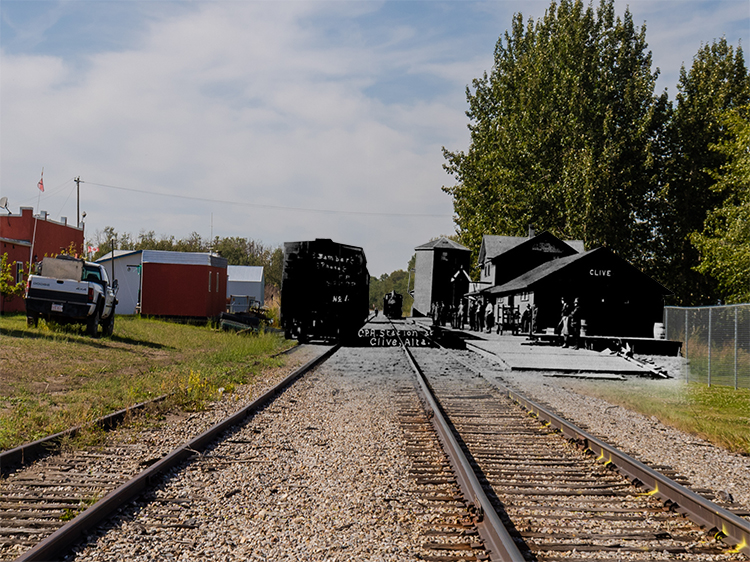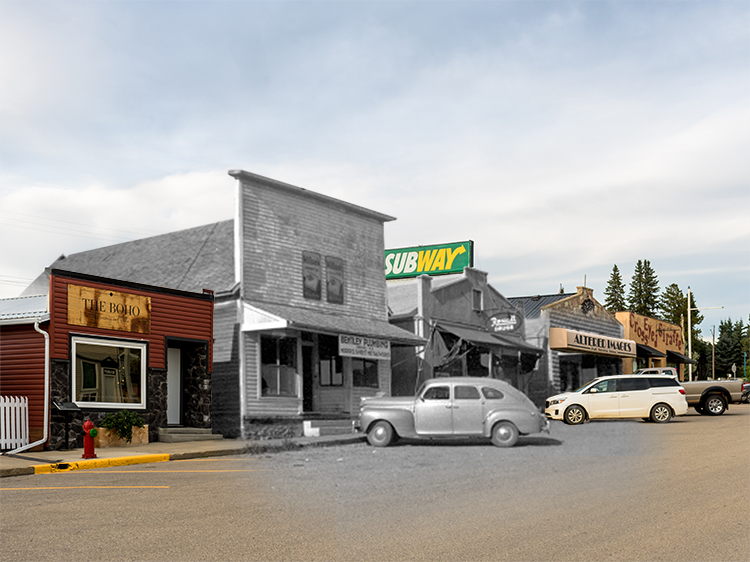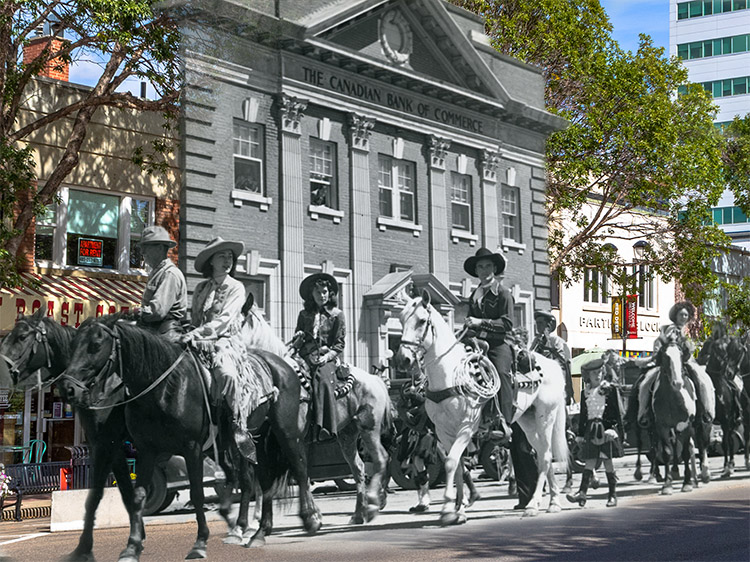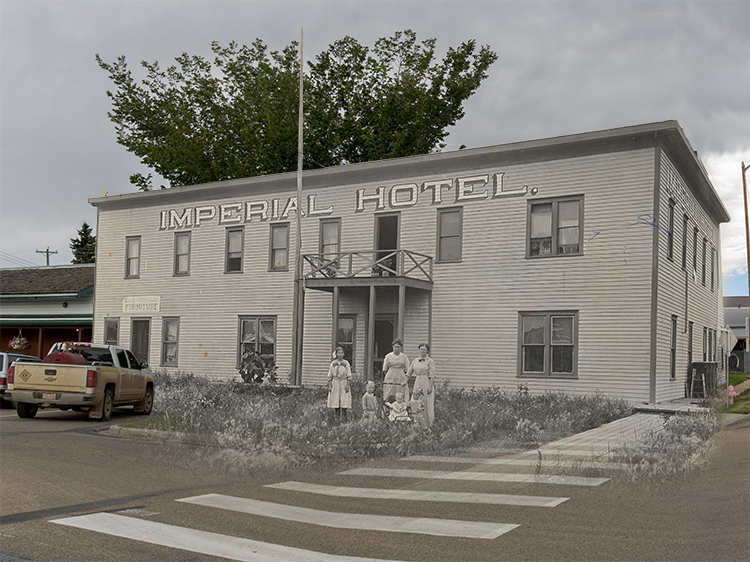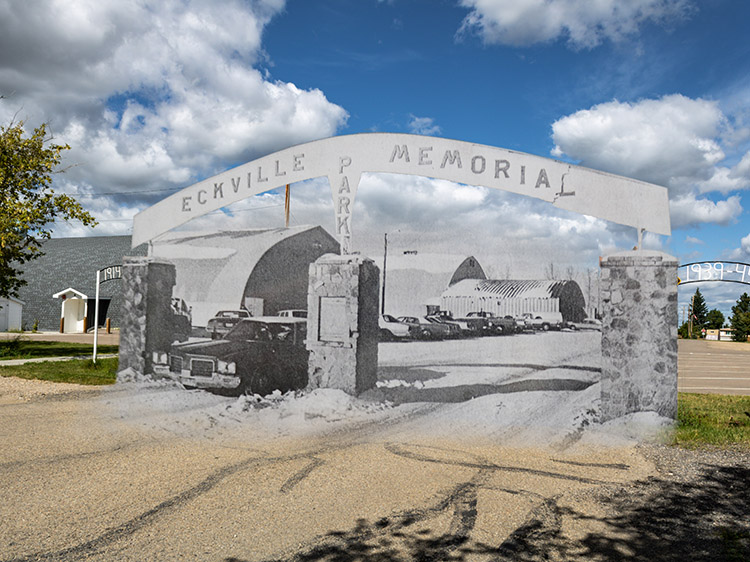Walking Tour
Intrigue on the Prairies
Drama and Mayhem in Lacombe's History
Elyse Abma-Bouma
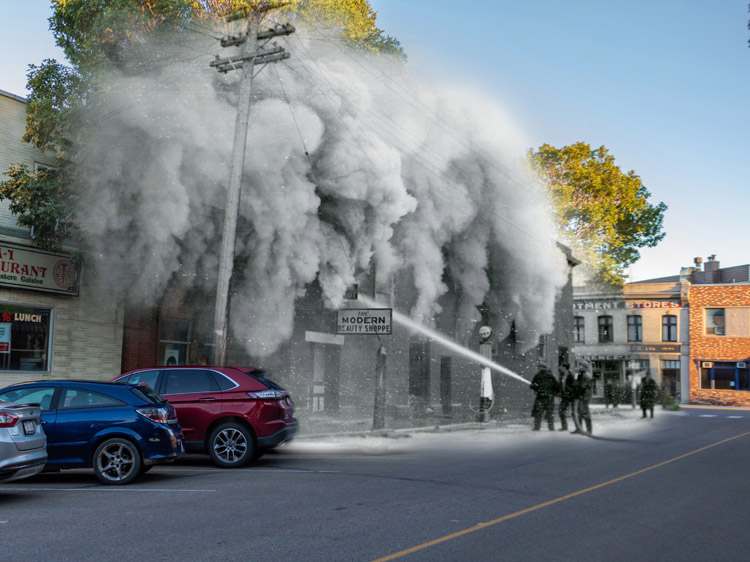
Lacombe & District Historical Society 2011.3.19
The history of the small town of Lacombe is packed with intrigue and drama. Despite its size, the community has been the site of mysterious fires and deadly snow storms, kidnappings and epidemics. Its people have come together to build hospitals, churches, and schools, all while bravely facing the hardships that come with life on the prairies.
On this tour, we will explore what life was like in the early days of this dusty town, discovering the stories of its first doctors, businessmen and politicians. We will delve into the tragedies of the many fires that struck the town, not all of which were caused naturally, and hear the tale of a Lacombian blacksmith kidnapped by the Ku Klux Klan in a case that shocked the province. And we will discover the many acts of kindness and bravery, both big and small, which shaped the identity of Lacombe.
This project is a partnership with Lacombe Regional Tourism. We also wish to thank the Michener House Museum & Archives for their generous support.
1. Setting the Scene
ca. 1910s
It's hard to imagine, looking down 51st Street, what Lacombe once looked like. In 1910, the sidewalks were far and few between, and the ones that did exist were wooden, built to keep the townspeople from sinking into the mud and to protect ladies' skirts from excessive dust and grime. Perched atop a telephone pole, the two men in this photo are hard at work fixing a broken power line. From their perch, these two would have seen an established prairie town, consisting of a photography studio, a handful of churches, storefronts, and even some of the first brick buildings to pop up at this time. 1
* * *
"A new arrival was observed the other day standing on the sidewalk in front of Morrison-Johnstone's store weeping as if his heart would break… As soon as he had composed himself he sobbed that it was only a case of homesickness. He was from Missouri and near his home was a large hog wallow which the hogs for miles around were wont to frequent. He said that sight of Barnett Ave. brought so forcibly to his mind that sport back home that he could not help but weep. All that was needed was a few hogs to make the picture true to life."2
Sidewalks like the one you stand on now didn't make an appearance until the 1920s. As automobiles began to replace horse-drawn wagons, it became apparent that cars and pedestrians should have seperate avenues to move about the town. Even the wooden boardwalk you see in this photo was something of a luxury in the bare-bones towns of the West. It was the responsibility of the shopkeepers to build sidewalks in front of their shops to keep their patrons from sinking into the mud!
So, what was Lacombe like when it began in 1893? It was dusty and littered with haphazardly placed wood-frame buildings. Winters were cold and bitter, and summers hot and dry. The people worked hard and bonded together. Churches thrived as community centres, insiders were wary of outsiders, and so Lacombe grew.
2. Epidemics and Public Health
Lacombe & District Historical Society
ca. 1910s
Medical care in Lacombe has come a long way from its early beginnings, when doctors were in constant demand and epidemics often swept through the population. Though you wouldn't guess it, this was the location of Lacombe's second hospital. Opening its doors in December of 1909, the hospital was expanded in 1922 due to a growing community. This building remained in use until 1937, when the Lacombe and District Community Hospital opened with thirty beds. It too soon expanded, increasing to fifty beds twelve years later. It was not until 1967 that the hospital used today opened its doors to care for the sick and dying of Lacombe.1
* * *
"Direction also corresponds to different aspects of humanness: north is associated with the cognitive realm, east is associated with the spiritual realm, south is associated with the emotional, or psychological realm, and west is associated with the physical realm. All of these areas connect in a holistic manner to represent a continuum or a balance. It represents the interconnectedness of all human aspects of growth, all human aspects of self, as well as connectedness with the four directions, seasons, medicines, environment, and cosmos."2
The medicine practices of the Nêhiyaw-Askiy (Plains Cree) are holistic and complex. They are still practiced today, despite colonial efforts to destroy cultural practices such as the Medicine Wheel and the Sweat Lodge.
When the first white Europeans settled in the area, medicine was quite primitive among them.
"Hospitals were unknown to the early doctors. Extreme cases might be taken by train to hospitals located in Calgary or Edmonton. But for many surgical operations, whether major or minor, the kitchen table or conditions equally primitive had to suffice. Occasionally patients were hospitalized in a hotel room or in the immigration shed."3
With a widespread farming population, being a doctor in early Lacombe was no small feat. Nancy Locke, wife of Dr. Locke, who practiced in Lacombe from 1919-1950, recalls that the two of them could scarcely sit down for dinner without a call:
"Our meals were a continuous nightmare because the telephone rang endlessly...In the early years he used the livery; we would just phone in and the boy would come and drive him to his destination and back again. When the winter roads were bad, he would often be gone for a couple of days at a time."4
Many illnesses swept through Lacombe:
"In the early years of the settlement of the west, diphtheria...was a dread disease which was very prevalent and few families escaped it. There were always many fatalities associated with an epidemic and the only method known to keep it under control was the enforcement of a strict quarantine."5
Much like recent days, Lacombians were subject to quarantine in the face of public health crises. In 1903, the Lacombe Advertiser and others printed notices in the paper about the threat of smallpox, chickenpox, Scarlet fever, measles, diphtheria, and cholera.
"WARNING: Should you neglect to put up the notice [of the above diseases], you would render yourself liable to a fine of $50 and costs." 6
The post was sent to Albertan businesses with the threat of a fine if they did not "post it plainly" that those infected would have to quarantine and identify their household as infected.
3. Dust and Dirt
1896
Taken in the year Lacombe was established, this photo of Nanton Street is unrecognizable against the modern setting. Close your eyes and try to imagine this place in 1896: take a deep breath and smell the horse dung and hay from the nearby livery; hear, in the distance, the clanging of the blacksmith's hammer, the clopping of horse hooves, and the rolling of an uneasy wagon. In Lacombe's early days, nature was everywhere, untamed even in the center of town.
* * *
"The body of S. Harbison, the young rancher lost in the snow storm of Sept 27, was found...on Friday [Jan 28, 1901] 13 miles from his ranch on the Paint Creek near that Battle river, east of Lacombe. He had unsaddled near a small clump of willows, tethered his horse to a bush, wrapped himself in his saddle blanket and evidently laid down and slept to death. HIs horse had got the rope around his heels and had thrown itself and was unable to get up and perished with his master. Harbison comes from Hamilton, Ont., and was about 24 years of age."1
With the lack of communication technology at the time, getting lost in a blizzard meant definite and serious trouble, sometimes ending in tragedy like in the case of Mr. Harbison and his horse.
4. Tarred and Feathered
Lacombe & District Historical Society 2014.37.2
ca. 1914
Lacombe's third blacksmith shop was built in either 1902 or 1903, by A.F. Weddle, and changed ownership many times in short succession. It was used exclusively as a blacksmith shop until 1939, when it became a workspace for other metal arts as well. Today, it is a museum devoted to blacksmithing.
A Lacombe blacksmith shop like this one was the scene of a violent kidnapping in 1930 that shook the community and drew the eyes of all Alberta onto Lacombe.
* * *
"Mr. Doberstein, who is a local blacksmith, was called down to his shop by someone who wished a piece of welding done at about 11 o'clock Thursday night. Upon arrival he was seized by two or three men and was taken by them in a sedan car and driven to a spot about ten miles out of Lacombe, where a coat of tar and feathers was administered, after he was beaten up and his hands and feet tied. He was left in this condition by the marauders."1
The Ku Klux Klan is a terrorist group based on white supremacy that formed in Tennessee in 1865. By 1921, branches of the KKK had made their way to Canada and, although they never developed the same roots in Canada as in the United States, there were chapters of the vigilante group throughout the prairies, including a sparse few in Lacombe.2
Unlike many victims of the KKK, Doberstein survived the attack. After being abandoned, he managed to loosen his ties and walk to Blackfalds. From there, he called a car to take him back to Lacombe and promptly reported his attackers to the police.
As if the event itself wasn't devastating enough, the trial of a few of the accused men was a very public and widely reported affair in Alberta. Among others, Ole Boode, Walter Butlin, and Ralph Mowbray were all identified by Doberstein and accused of kidnapping and assault.
"So far as the public is concerned the only ones who will suffer in consequence of the recent Doberstein outrage, are those who participated in the affair. The sympathy of the entire country is with the victim."3
In the end, only two of the five attackers were charged. Ralph Mowbray, a mail carrier in the Lacombe area, and Walter Butlin, a square dance caller for the Old Timers Association, where both "charged with the unprovoked assault on Fred Doberstein" and fined $50 in addition to their legal fees.4
Throughout the arrest, trial, and conviction, Lacombe's Charles Halpin of the Western Globe remained outspoken about the Ku Klux Klan. On June 5, 1930, the KKK sent the newspaper a letter outlining how Halpin had offended the Ku Klux Klan. The Western Globe promptly published the letter saying:
"Threatening letters are one method these Hooded Cowards make use of to intimidate those who dare to oppose them in their nefarious acts, but only a fool will pay attention to that method of procedure. The K.K.K. has no place in Alberta; the type of men who rally round their fiery cross are not of the calibre any place would want to enforce their laws."5 6
These bold words from Charles Halpin in the face of the Ku Klux Klan clearly expressed the disdain and horror that many were feeling in light of the events of 1930, and proved that the West would not be lawless after all.
5. Snake Oil
Lacombe & District Historical Society 90.1.376
ca. 1900s
The Corner Business Block, otherwise known as the Flat Iron Block, was one that continually fell victim to fire. Originally constructed in 1903, it burned to the ground in September of 1906. It was rebuilt quickly and completed in 1907—only to burn down once again in 1911. The current building was constructed in the late 1920s, making it the longest standing version of the block. Third time really is the charm.
* * *
"The McDermid Drug Co. has gone to a lot of trouble to make their store attractive for the Xmas buyer...here a full line of fancy goods, books, toys, etc., will be found, and the stock range of choice is unlimited."2
Among all of the toys, medicines, and general household goods, there was one particular product McDermid's advertised over and over again: Dr. Shoop's Restorative. A miracle cure for nerve conditions of all kinds, Dr. Shoop's Restorative promised relief to the ailing and good health to the sick. Too much sun? Pulled a muscle? Have an ache or pain? Dr. Shoop's was there for you!
"Heat prostrates the nerves. In the summer one needs a tonic to off-set the customary hot weather nerve and strength depression. You will feel better within 48 hours after beginning to take such a remedy as Dr. Shoop's Restorative. Its prompt action in restoring the weakened nerves is surprising...That tired, lifeless, spiritless feeling will quickly depart when using the Restorative...Test it a few days and be convinced." 3
Dr. Shoop himself was a doctor in Wisconsin who made his fortune selling miracle cures—until, that is, a new drug law in the United States required all medications and "cures" to disclose their ingredients. After the new regulations, Dr. Shoop's Restorative became a "remedy" instead of a "cure". Dr. Shoop also expanded his business to include other things, such as printing and publishing. 4
So what was this miracle cure that was healing all of Lacombe? Dr. Shoop's Restorative contained 12% alcohol; it's no wonder that everyone felt a little better after taking a swig of the "miracle cure."
6. "Ever-Present Hazard"
1906
Looking at Lacombe's Main Street today, it's difficult to imagine that it once lay in smoldering ruins. On September 7, 1906, a fire started in the kitchen of McDermid's Drug Store. The flames spread quickly, and soon the whole block was ablaze. 1
Many early prairie settlements had a problem with fire. Early structures in these settlements were built of wood, since that was the quickest, lightest, and most readily available material. This, in combination with the wind and dry conditions, made it so that fires started easily from stoves or candles.
* * *
"The disastrous fires which have visited Lacombe during the past few years have been commented on very strongly by the insurance companies and the public generally. Not one of the big fires has been accounted for, although the circumstances surrounding most of them were very suspicious, and none of them have been thoroughly investigated." 2
In 1906, the fire which started in the kitchen of McDermid's Drug store took out most of the downtown block. Only the stone bank building and one of the drug store's brick walls stood the test of the flames. The great fire of 1906 caused the new town of Lacombe to create a fire department for future blazes. The fire brigade was carried by volunteer labour, and since water lines were not well established in the town yet, water had to be pumped in from a distance. 3
In August, 1909, Sophie Hansen, a domestic worker, smelled smoke and saw flames at the Royal Hotel.
"At 3:30 o'clock Wednesday morning fire was discovered in the rear rooms of the Royal Hotel. From all appearances the fire had broken out in the kitchen, though its origin is purely a matter of conjecture as nothing whatever is known as to the cause."
The O'Grady Brother's meat market on the east side of the Royal Hotel soon caught fire, and flames quickly spread to a photo studio and a nearby house. Next, the fire spread to Ole Boode's second hand shop (Lars Boode was living on the second storey, but escaped harm), and, lastly, caught the home of Mrs. Curry and burnt it completely to the ground.4
In January, 1911, the Victoria Hotel, Alberta Drug Co., Hop Chung's Restaurant, Puffer's Butcher, the Masonic Lodge, a furniture store, and a warehouse were all taken by fire.
"About 5:30 on Tuesday morning the citizens were startled by an alarm of fire, and in a few minutes flames were seen issuing from the north side of the Victoria Hotel...A fierce gale was blowing at the time, and it was recognized from the start that only the most heroic efforts on the part of the fire fighters could save the business portion of the town from destruction."5
In June of 1914, fire befell Lacombe yet again! This time, it was the Russel Block that was reduced to ash:
"At about 10:30 o'clock on Tuesday morning...the Russel Block was discovered to be on fire...It soon became evident that the building could not be saved, and all further efforts were given to confining it to the building."6
Many other fires cursed Lacombe. In 1911, the Cummings Rink burned down, and in 1953, the Lacombe Memorial Centre and Arena went up in flames. On June 18, 1968, the Lacombe Ice Centre burned down, contributing to a legacy of ice and fire in Lacombe's recreation centres.7
No matter how many firefighters volunteered or how many buildings were reinforced with brick, Lacombe could not evade the legacy of fire and the tragedy of lost goods. For over a hundred years, the people of Lacombe have rebuilt from the ashes only to be struck again by disaster.
7. Produce Arson
Lacombe & District Historical Society 90.1.887
1930
At the end of Barnett Ave lies the Day Block, built in 1903 by Alf Day, who operated a general store in Lacombe's early days. An impressive brick structure, the Day Block was part of the McLeod Quarter and has housed many businesses throughout the years, including Horne and Spice General Merchants (1904), W.E. Lord Company Department Store (1908), F.E. McLeod's Grocery and Ladies Wear (1910), and the Tiki House (1980s). Upstairs was Day's Opera House, which hosted many events, including Lacombe's first movie in 1909.1
The intrigue, however, lies next to the Day Block. Look just to the left and you'll see a shorter brick storefront. Prior to the existence of this brick facade, the Lacombe Produce company stood on this spot in a typical wood-framed building. One would not tend to think that a shop selling fruits and vegetables would be the centre of scandal, but under the right conditions, nearly anything can be.
* * *
"At 12:30 am Thursday, fire was discovered in the building owned and occupied by the Lacombe Produce Co. on Barnett Ave. East. When noticed the fire had evidently been burning for some time for within a minute or two the entire building was a mass of flame and beyond help from the fire brigade...How the fire started is a mystery up to the time of going to press."2
The fire was suspicious from the start. The manager of the Produce Co. had not seen the fire start, and there were no stoves in the building. Lacombe residents were tired of fires driving up their insurance, and started a petition to have the fire fully investigated. It was eventually signed by 100 people.
"The fire was evidently of incendiary origin… When the fire was noticed the side doors on Glass St. were unlocked and it was just inside these doors that the fire started. Lacombe is becoming celebrated for mysterious fires and the council is determined that hereafter these mysteries will be investigated."3
Rumors began to spread throughout Lacombe about the possible nefarious motivations behind the Produce Co. fire, most of which came to nothing. But residents were right in some of their suspicions. Just a week after the fire, Samuel C. Wilson and his mother-in-law Mrs. Georgina Girvin were arrested for arson.
"The citizens of Lacombe were not surprised at these arrests. At the time the fire occurred everything pointed to incendiarism and it was only natural to connect parties interested with the affair...It was discovered that [Mrs. Girvin] came up to Lacombe on the 1st and remained here until after the fire on the 3rd. It is said on the night previous to the fire she was caught on the premises of the Produce Company and she will have a time showing what she was doing there."4
Samuel Wilson himself was a mysterious character, "reputed to be worth anywhere from $1 to $75,000", and no one was quite able to identify which it was. Wilson and Girvin were granted bail of $40,000, which they paid and proceeded to await their trial.
By the end of March, a date was set for the trial and all of Lacombe watched with eagerness. Witnesses were summoned in the trial and the evidence was damning:
"Mr. McIntosh, his daughter and a visitor named Hunter...swore that while returning from singing class on Wednesday night...they discovered [Mrs. Girvin] in the building. They experienced difficulty in opening the front door [of the Produce Co.], but when they succeeded in gaining admittance they found that a spoon handle had been jammed into the latch from the inside."5
Throughout the trial, it came out that Mr. Wilson had in fact taken out a few too many loans from the bank and was struggling to repay. Wilson conspired with his mother-in-law to commit insurance fraud by burning down the building. Mrs. Girvin entered the Produce Co. through the side door and stuck a spoon handle in the lock of the front door to prevent any employees from entering. She then likely used some sort of flammable liquid to start the fire. Samuel C. Wilson was sentenced to three years and Mrs. Georgina Girvin to two.6
8. Urquart and Lundie
Lacombe & District Historical Society 90.1.914
ca. 1910
Staff pose in front of Urquhart's Department store in 1910. Built in 1907 by A. Urquhart, the department store took advantage of the prime real estate left behind by the 1906 fire. A unique feature of the department store is that it has two storefronts due to the triangular plot of the Flat Iron Block. In 1918, the building sustained smoke and water damage from a nearby fire, but it was repaired. Today, it looks very similar to its original self.1
* * *
"Mr. Urquhart will be long remembered by old-timers as a member of the Town Council, a member of the Hospital Board and School Board."2
During the days of its operation, Urquhart's department store sold any number of goods, including clothing and luxury items. During the Christmas season of 1911, Urquhart's advertised its "heavily stocked Santa Clause department" where "buyers will find no trouble in getting toys that will please." For the "grown ups", Urquhart's carried "an unlimited supply of Xmas novelties, fancy handkerchiefs, neckties, and a thousand and one pretty and appropriate articles for the festive season."3
Other items advertised were Sunset Golden Pancake Flour for $3.25 per 100lbs 4 and Ladies Taffeta Gloves for 30 cents.5 The store also hosted contests for large ticket items such as pianos:
"We have jointly arranged to give the above magnificent prizes to the Ladies who will receive the Greatest Number of Votes during the next Three Months."
Women were nominated for these contests and Lacombe residents could go to either the Western Globe offices or A. Urquhart's Department store to cast their votes. First prize was a Krause Upright Piano worth $350, which is somewhere around $8,000 today! Imagine the rush the winning lady must have experienced upon receiving such a prize!6
9. A Jaded Lover
ca. 1920s
Hotels were some of the first businesses in the settlement of Lacombe. The Empress Hotel was originally called the Winnipeg Hotel, but had its name changed when it was sold. The new owner, D. Lockman, deemed that the name "Winnipeg Hotel" was not appropriate. The Empress was built in 1911 and operated as a hotel and bar for many decades.1
* * *
"Mrs. Davies...said she first got acquainted with Pallent last winter shortly after Christmas. He had been sent to her by her husband who was not working but was living on the money she could provide. [Her] husband had forced her to lead a life of prositiution to provide money for him...Pallent had arrived from Lacombe, coming for the purpose of getting money from [Mrs. Davies] as he also was living off her earnings."3
Pallent came seeking money from Mrs. Davies. Little did he know, he would never return to Lacombe. On September 25, 1913, Pallent checked in to Foskett's Boarding House in Edmonton. He went out for the day and returned at about 5 o'clock, drunk and with Mrs. Davis. Shortly after they arrived back at the house, Mrs. Davis and Mr. Pallent began arguing about Pallent's infidelity. Pallent denied the accusation and laid down on the bed.
"Almost insane with jealousy...Mrs. Dean Davis...shot and instantly killed Sydney Pallent...The woman fired six shots from a .32 Police Positive revolver. Three bullets found a mark in the body of the man: one entered his right shoulder, another his right arm, and a third pierced his heart, causing almost instant death." 4
"After she had fired the shots Mrs. Davis must have dragged the body into the living room and then brought a pillow and placed it under the dead man's head...The tragedy created intense excitement in the neighbourhood and drew a tremendous crowd of sensation seekers."5
Sydney Pallent had been shot dead by what the police had initially thought was a jaded lover. It would, of course, eventually come out that Mrs. Davies was a woman forced into prositiution by her husband. Both Mr. Davies and Mr. Pallent were using her as a source of income for themselves.
"[Mrs.Davies'] father and brother testified that up [until] the time of her marriage she was a girl of good character. Witnesses who knew Pallent intimately testified that he made a practice of extorting money from unfortunate women, and that when he could not wheedle it out of them he did not hesitate to use threats."6
10. Puffer and Chung
Lacombe & District Historical Society 90.1.851
1950
Though the original Masonic Temple was located above Puffer's Meat Market, it was relocated here when the original was lost in the Victoria Hotel fire of 1911. Today, this building functions as the Masonic Eureka Lodge No. 10, just as it did when it was first constructed over one hundred years ago.1
* * *
W.F. Puffer was a butcher in town with a shop on Nanton Street. In 1902 and 1906, he was elected as a councilman in Lacombe, and he also served as the town's Liberal MLA. In 1945, he was honoured for his 50 years of business in Lacombe and was hailed as a longtime community member. He was heavily invested in the community of Lacombe, advocating and raising money for road improvement, serving on town council, and remaining active in business and politics for decades.2
Hop Chung was a Chinese immigrant who started a restaurant and laundry in Lacombe sometime prior to 1900. In addition to working jobs which most European Canadians did not want, Chinese immigrants were often met with racism and contempt. For example: when Alberta was starting to gain traction in the prohibition movement, the "booze brigade" in Lacombe was doing its best to round up more votes to keep liquor legal. The Western Globe reported prior to the prohibition vote:
"Well, the booze brigade has gotten right down to hard pan here...as a last resort the liquor people are digging up the Chinamen-- the people that all political parties have striven to keep off the voting list for years...It is up to all white people to show their disapproval of the action of the liquor men in putting the Chinese on the list, and we think the action of those responsible will be strongly resented."3
At the time, Chinese immigrants were charged a punitive head tax on entry into Canada. At $1,500, the tax was so prohibitively expensive that the mostly young and male immigrants could rarely afford to bring their families to Canada as well.
W. F. Puffer helped Chung by lending him the money for his wife and two children to come to Canada (a $1500 head tax would be somewhere around $34,000 today). Puffer and Chung eventually became business partners and built the Puffer Chung block on Nanton where Hop Chung's restaurant and Puffer's Meat Shop were located.4
11. Little School on the Prairie
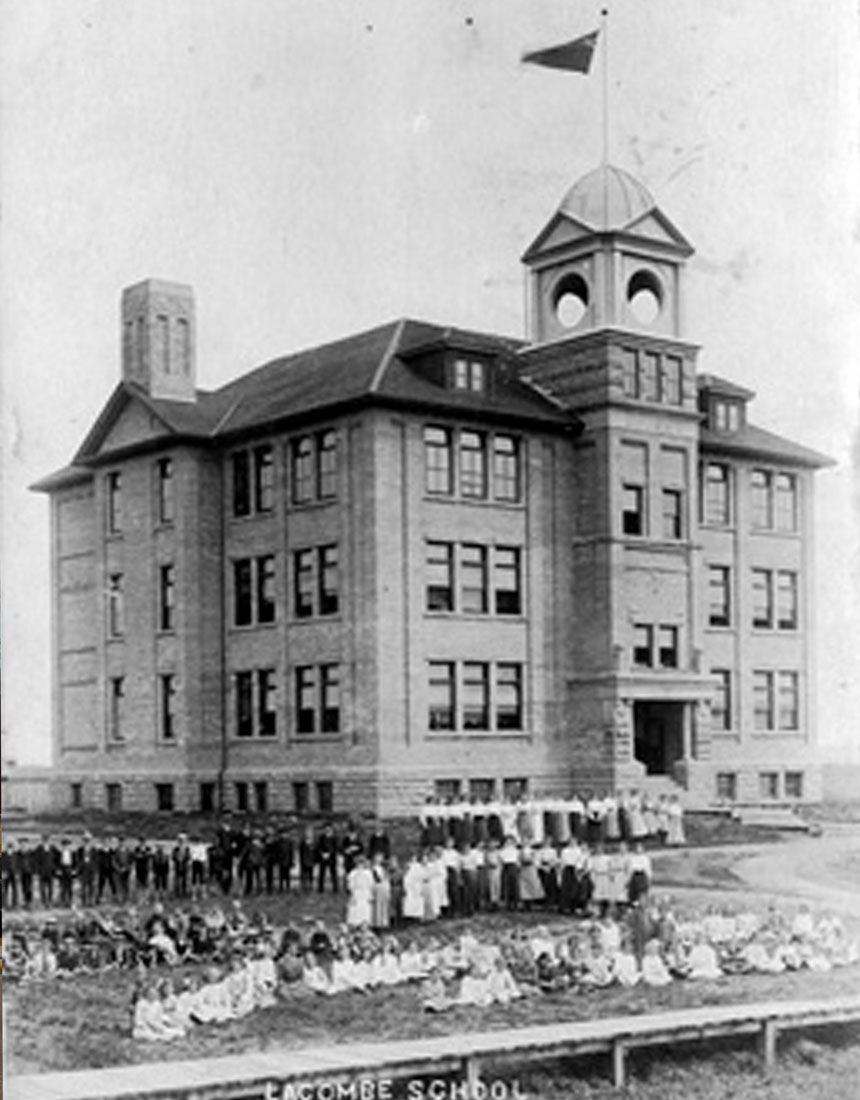
ca. 1910
This photo of the Nelson School with the teachers and students on the front lawn was taken in 1910, just a year after the school building was completed. Today, the Father Lacombe Catholic School stands on the spot. The spot is actually three blocks north of here, at 54th Ave and 52nd Street.1
In 1906, it was decided that Lacombe needed a larger school. $25,000 was set aside for a vast expansion of the one-room schoolhouse. The committee must have been overly optimistic about the potential growth of Lacombe, because for the first several years, only seven of the rooms in the three-storey schoolhouse were used. The Nelson School was finished in 1909 and the final cost came in at $40,336, far above budget.
Nevertheless, the Nelson School was built; there was no going back. Like many schools (and the town of Lacombe itself), the school was named for a missionary.
* * *
Nelson did his job poorly, caring nothing for his students and the people to which he was sent. Among other atrocities, Nelson was accused of neglecting students at the residential school in Red Deer and Maskwacis (then called Hobbema) by refusing them healthcare during tuberculosis and other epidemics.3 Nevertheless, Nelson's bleak record did not deter the town from naming the school after him. Perhaps most people instinctively thought of Admiral Nelson, hero of Trafalgar, instead of the ignoble local hero.
Thankfully, unlike life at the schools run by Rev. Nelson, education at the Nelson School in Lacombe was the town's pride. Meant for white children in the community, the Nelson School's largest problem was that it was too large and too expensive. But this did not mean that the work of the teachers was easy. Peter Talbot once said:
"It was the women, however, who were responsible for making it such a great success. They insisted upon a school being built before anyone was really established."4
An early school teacher in Lacombe wrote this of her experience in the schoolhouse prior to the building of Nelson School:
"Imagine my surprise when I entered the new room-- not a single desk for the pupils but a chair and table in one corner for the teacher, a blackboard on the wall and planks nailed on blocks of wood for sixty pupils...Our first visitory was [the inspector] who was concerned at having so many pupils in such a small quarters, especially when he found the cellar full of stagnant water."5
Clearly, a new schoolhouse was necessary. And so the Nelson School came to be.
12. Dr. Sharpe
Lacombe & District Historical Society 90.1.1056
ca. 1950s
The Dr. Sharpe House you see in front of you is one of Lacombe's remaining heritage houses on Main Street. Built in 1914 by Dr. E. M. Sharpe, this home has changed very little since its construction. Most likely built by Sam Watt, this residence was constructed to serve as a doctor's office as well as a home.1
* * *
Dr. Sharpe was ambitious and determined. Prior to purchasing the Lacombe practise from Dr. Richardson, he had opened up his own practise in 1894 in Wetaskiwin. While he was sitting in his hotel lobby in that town, a "genial janitor" offered him a drink:
"'No thanks, I don't drink' [he replied]. 'You don't drink!' Exclaimed the janitor. 'Well you sure will be a curiosity out here.'"3
Though he may have been an oddity to some, Dr. Sharpe was most certainly needed in Lacombe. The town had the only medical centre between Wetaskiwin and Red Deer, and many came from far in the prairies to see the doctor. Mostly, however, Dr. Sharpe would venture out to see them. Usually travelling by horse, he could be gone for days to tend to one of his patients.
"All doctors, if they were not horsemen, quickly had to become such for there was no other mode of travel. Their practice extended from Gilby and Rimbey to the west to Alix and Mirror to the east. To arrive home from a 20 or 30 mile ride and find another call involving an equal distance awaiting them was not unusual."4
We can be sure that Dr. Sharpe saw a lot in his 44 years as a doctor in Lacombe. In May of 1909, Dr. Sharpe insisted on an inquest when the body of an infant was found buried just outside of town.
"[T]he confessed mother of the babe was arrested on Monday… for her preliminary trial on the charge of concealment of birth which caused the death of the child. From her statement the child was born on March 24, and was kept concealed in town until May 4th when she and a young man named Ab. Saunders, took the corpse out to Spruceville and buried it...Ab. Saunders was arrested as an outcome of [her] statement."5
Indeed, tragedy frequented Lacombe in those early years, and it was Dr. Sharpe who tended to those who fell victim to unspeakable horrors. But not even a doctor can escape his own tragedy. At the end of March, in 1929, Mrs. Sharpe suffered a stroke. Though it looked for a moment like she was on her way to recovery, she passed away a couple of weeks later on April 11, 1929.
"The community was deeply grieved to learn of the death on Thursday morning of Mrs. E. M. Sharpe...Stricken with paralysis on the evening of Saturday March 30, she never recovered."6
Dr. and Mrs. Alice Susan Sharpe had been married for nearly 25 years. She suffered a sudden stroke and left Dr. Sharpe a widower with their two daughters Bessie and Lily. Mrs. Sharpe had been an active community member like her husband, serving in the Methodist Church as well as the Women's Missionary Society, and as the regional superintendent of the Woman's Christian Temperance Union.
13. Lacombe at War
Lacombe & District Historical Society 90.1.384
1940
Though its surroundings have changed, Lacombe's Cenotaph has remained the same. Erected by the Lest We Forget Club in 1924, the Cenotaph is a reminder of the sacrifices made and lives lost during the First World War. Inscribed with the 72 names of the Lacombians who lost their lives in the war, the memorial offers a point of solemn reflection for the toll that a war can take on a small prairie town.
* * *
Howard Duffy was the youngest of Pat and Julia Duffy's six children. During the Second World War, at just 18 years old and with only a tenth grade education, Howard left his family farm east of Lacombe and headed to Calgary to enlist.
"I was assigned to the Fifth Canadian Armoured Division...and was to report to training right away...The troops were sent to the lines. We were first sent to Naples, Italy. Althrough the war we were stationed in almost all of the Mediteranean countries and in North Africa for a while. I was on the line for about two years."1
Howard Duffy returned home to his family in 1945, just prior to the end of World War Two, after requesting his discharge. Not all were so fortunate.
Jack Lundie, son of prominent Lacombe businessman Alfred Lundie (who purchased Urquart's business in 1914), enlisted in World War One overseas some time in late 1916.
"Jack Lundie was up on last leave from Sarcee last week, and returned to Calgary on Saturday morning. His regiment is expected to leave for overseas shortly."2
Imagine that last visit to Lacombe prior to being sent out to war. Sitting down for dinner with his family, trying to soak in the normalcy of life in Lacombe before venturing out into the unknown, where his life would constantly be at risk.
Jack did return home, and became a farmer in the Lacombe area, as the Canadian government encouraged many veterans to do upon their return.
Jack's mother, Mrs. Lundie, along with some other women in the community, were determined to ensure that the sacrifices of Lacombe were not forgotten. On February 22, 1922, Mrs. Lundie, Mrs. Simpson, Mrs. Aldwinkle and Mrs. Oakley founded the Lest We Forget Club with the sole purpose of commemoration. These women secured a piece of land from the school board and $4,850 later, they erected the memorial statue you see before you today. Jack Lundie read the King's message on the day of dedication, and flowers were placed on the graves of each of the dead.34
14. St. Andrews Church
Lacombe & District Historical Society 90.1.2379
ca. 1920
St. Andrews Presbyterian Church was dedicated in 1909, and the current entrance was added in 1965. One of the few buildings from early Lacombe left untouched by fire or decay, the St. Andrew's Church stands nearly the same today as it did over 110 years ago.
* * *
The Grace Methodist Church and St. Andrews had been sharing the space to worship during the summer months, and the Grace Methodist thought it might be a good idea to combine their congregations. It was put to a vote in 1915, but ultimately struck down; the Presbytarian congregation was hesitant of the union. But Grace Methodist persisted, letting St. Andrews know that the option was always there. In 1922, the congregations joined to create the St. Andrew's United Church that you see before you today.
The combining of the congregations meant that the Grace Methodist building could be used as a church hall (which you can see to the right of the church), and their fundraising and donation efforts were joined.
"St. Andrew's has a rich history. Today the red brick structure on the corner is an active centre. Church and community groups come and go. Weddings and funerals mark the flow of time with scarcely a week missed. On Sunday mornings. The mellow peal of the only church bell in town calls the people to worship."1
Churches were a vital component of prairie communities, functioning as community networks for social assistance, volunteering, education, community functions, and social gathering. Congregations leaned on each other to survive the prairies and joined together in their faith to accomplish things that would have been impossible alone. Immigrants often used churches to help with the immigration process, by connecting with sponsors and ensuring that they had housing and work when they arrived.
15. Claim to Fame
Lacombe & District Historical Society
ca. 1900s
Not many of the early buildings in Lacombe were so lucky as to survive the constant threat of fire. However, the house that has now come to be known as the Michener House is one of the few. Built in 1894 as the Methodist Church parsonage, this structure is a typical and functional wood-framed building from the early days of Lacombe's settlement. In 1977, it was declared a provincial historic resource, and it opened as the museum it is today in the mid 1980s. But who is Michener and why have we heard that name before?
* * *
A strong contender for Lacombe's most famous resident, Daniel Roland Michener became Governor General in 1967, which was the cherry on top of an already illustrious career as a Rhodes scholar, lawyer, Conservative Party Member of Parliament and Speaker of the House of Commons. With a lengthy roster of accomplishments, Michener was appointed Governor General after the sudden death of the previous Governor General, Georges Vanier.
Of course, Roland Michener's life was not all politics and law. Michener married Dr. Norah Willis in 1927 and together they had three daughters. After his appointment as Governor General, he continued to serve his community on many boards and by continuing to speak at events and such until his death in 1991.11
Endnotes
1. Setting the Scene
1. "Postcard 12265: Lacombe, Alta.. cca. 1910," http://peel.library.ualberta.ca/postcards/PC012265.html (Accessed February 15, 2021)
2. "Street Improvement" in "Lacombe: The First Century," 15.
2. Epidemics and Public Health
1. "Lacombe: The First Century," 223-4.
2. Sarah L. Binsfeld,"Traditional First Nations and Métis Healing Methods,"19. https://harvest.usask.ca/bitstream/handle/10388/7524/BINSFELD-THESIS-2016.pdf?sequence=1&isAllowed=y
3. "Lacombe: The First Century," 213.
4. "Lacombe: The First Century," 211.
5. Gordon P. Puffer, "A Giant Among Pioneers," 85.
6. "Lacombe: The First Century," 209.
3. Dust and Dirt
1. "A Lacombe Tragedy," Edmonton Bulletin, January 28, 1901.
4. Tarred and Feathered
1. "Tar and Feather Outrage Charged Against K.K.K." The Wetaskawin Times, May 29, 1930.
2. Paul Banfeild, "Ku Klux Klan" https://www.thecanadianencyclopedia.ca/en/article/ku-klux-klan Published online February 7, 2006.
3. "Who Suffers from the Outrage" Western Globe, 1930.
4. "Assailants Pay $50 Fines" Western Globe, December 11, 1930.
5. "Western Globe Receives Threat From the K.K.K." Western Globe, June 6, 1930.
6. "Lacombe" https://www.unlockthepast.ca/Lacombe
5. Snake Oil
1. "Town of Lacombe Municipal Heritage Survey" 2010, 8.
2. "Christmas Week at the Stores" Western Globe, Dec 20, 1911
3. Advertiser and Central Alberta News, August 27, 1908 Page 5.
4. Erika Janik "Remembering Dr. Shoop, Racine's 'Patent Medicine King'" https://www.wpr.org/remembering-dr-shoop-racines-patent-medicine-king Published May 8, 2017.
6. "Ever-Present Hazard"
1. "Lacombe: The First Century" 269.
2. "Samuel C. Wilson and His Mother-In-Law Arrested for Arson," Western Globe, 15 March 1911, Page 10
3. Howard Freeden, "The Lacombe Community: Evolution by Fire" Published February 27, 2014. firehttps://www.lacombeexpress.com/opinion/the-lacombe-community-evolution-by-fire/
4. "Royal Hotel Burned" Advertiser and Central Alberta News, August 19, 1909, Page 1.
5. "Disastrous Fire Starts New Year" Western Globe, January 4, 1911, Page 11.
6. "Russel Block Burns" Lacombe Guardian, June 5, 1914, Page 1.
7. Howard Freeden, "The Lacombe Community: Evolution by Fire" Published February 27.
7. Produce Arson
1. Alberta Culture and Multi-Culturalism, "Historical Walking and Driving Tour: Lacombe," 13.
2. "Another Disastrous Fire" Western Globe, March 8, 1911, Page 5.
3. "Will Investigate Fire," Western Globe, March 8, 1911, Page 2.
4. "Samuel C. Wilson and and his Mother-In-Law Arrested for Arson," Western Globe, March 15, 1911, Page 10.
5. "Sent Up For Trial On Arson Charge," Western Globe, March 29, 1911, Page 2.
6. "Sam. C. Wilson Gets 3 Years," Western Globe, November 29, 1911.
8. Urquart and Lundie
1. "Through the Years: The Kanngiesser Building," www.lacombemuseum.com
2. "Andrew Urquhart Dies In Vancouver," Western Globe, December 3, 1936, Page 3.
3. "Christmas Week At The Stores," Western Globe, December 20, 1911, Page 3.
4. Alberta Advertizer and Central Alberta News, March 25, 1909, Page 8.
5. Western Globe, February 3, 1915, Page 6.
6. Western Globe, August 30, 1911.
9. A Jaded Lover
1. "Of Local Interest," Western Globe, June 12, 1912, Page 7.
2. "Lacombe Bartender Shot at Edmonton," Lacombe Guardian, September 26, 1913.
3. "Twelve Years for Slayer of Pallent," Lacombe Guardian, Oct 31, 1913.
4. "Lacombe Bartender Shot at Edmonton," Lacombe Guardian, September 26, 1913.
5. "Wave of Crime Swept Over City Last Night," Edmonton Bulletin, September 25, 1913, Page
6. "Twelve Years for Slayer of Pallent," Lacombe Guardian, Oct 31, 1913.
10. Puffer and Chung
1. "Lacombe: The First Century," 293.
2. "Lacombe: The First Century," 74.
3. "Just About Herr Windle," Western Globe, July 7, 1915, Page 8.
4. "Chop Suey on the Prairies: Racism and Immigration," http://chop-suey.chemistrycommunications.com/racism-and-immigration.html
11. Little School on the Prairie
1. "Lacombe: The First Century" 137
2. "Lacombe: The First Century" 136
3. Uta H. Fox,"Reverend Mr. John Nelson," https://www.unlockthepast.ca/Article-15-Reverend-
4. "Lacombe: The First Century" 135
5. Gordon P. Puffer, "A Giant Among Pioneers," 134-5
12. Dr. Sharpe
1. "E. M. Sharpe Residence" Alberta Register of Historic Places, https://hermis.alberta.ca/ARHP/Details.aspx?DeptID=2&ObjectID=HS+10533
2. "Lacombe: The First Century," 209.
3. "Lacombe : The First Century," 210.
4. "Lacombe : The First Century," 210.
5. "Ghastly Find at Spruceville," Advertiser and Central Alberta News, May 27, 1909. Page 8.
6. "The Late Mrs. Sharpe," Western Globe, April 18, 1929. Page 2.
13. Lacombe at War
1. Lacombe & District Historical Society, "At Home and Abroad, Stories from Lacombe," https://lacombemuseum.com/at-home-and-abroad/
2. "News of Lacombe and Vicinity," Western Globe, November 1, 1916. Page 5.
3. "Memorial Service," Western Globe, September 13, 1928. Page 2.
4. "Lacombe: The First Century," 280.
14. St. Andrews Church
1. "Lacombe: The First Century," 186-7.
15. Claim to Fame
1. "Roland Michener" Canadian Encyclopedia
Bibliography
Banfield, Paul. "Ku Klux Klan" Canadian Encylopedia, 2006. URL: https://www.thecanadianencyclopedia.ca/en/article/ku-klux-klan.
Binsfeld, Sarah L. Traditional First Nations and Métis Healing Methods. Graduate Thesis for University of Saskatchewan. 2016. URL: https://harvest.usask.ca/bitstream/handle/10388/7524/BINSFELD-THESIS-2016.pdf?sequence=1&isAllowed=y.
"Chop Suey on the Prairies: Racism and Immigration." Royal Alberta Museum, 2014. URL: http://chop-suey.chemistrycommunications.com/racism-and-immigration.html.
"E. M. Sharpe Residence". Alberta Register of Historic Places. URL: https://hermis.alberta.ca/ARHP/Details.aspx?DeptID=2&ObjectID=HS+10533.
Fox, Uta H. "Reverend Mr. John Nelson." Central Alberta Museums. URL: https://centralmuseumsab.ca/reverend-mr-john-nelson.
Freeden, Howard. "The Lacombe Community: Evolution by Fire." The Lacombe Express, 2014. URL: https://www.lacombeexpress.com/opinion/the-lacombe-community-evolution-by-fire/.
Janik, Erika. "Remembering Dr. Shoop, Racine's 'Patent Medicine King'". Wisconsin Public Radio, 2017. URL: https://www.wpr.org/remembering-dr-shoop-racines-patent-medicine-king.
Hillmer, Norman. "Roland Michener." Canadian Encyclopedia, 2008. URL: https://www.thecanadianencyclopedia.ca/en/article/daniel-roland-michener.
"Historical Walking and Driving Tour: Lacombe." Alberta Culture and Multiculturalism.
Lacombe & District Chamber of Commerce. Lacombe: The First Century. Lacombe, AB : Lacombe and District Chamber of Commerce, 1982.
Lacombe & District Historical Society. "At Home and Abroad, Stories from Lacombe and the Second World War." Lacombe Museum. URL: https://lacombemuseum.com/virtual-exhibits/at-home-and-abroad/.
Puffer, Gordon P. A Giant Among Pioneers. Edmonton, 1976.
"Through the Years: The Kanngiesser Building." Lacombe Museum. URL: https://lacombemuseum.com/virtual-exhibits/the-michener-house/.





